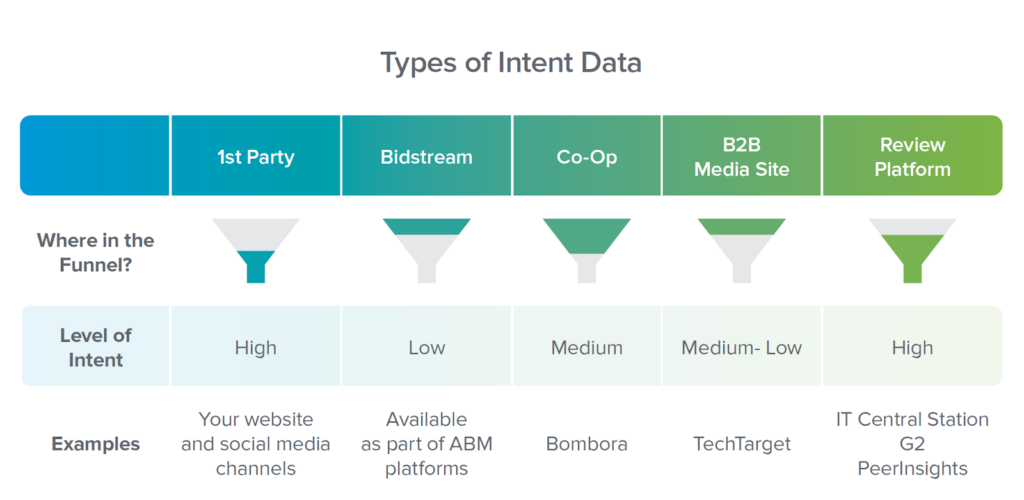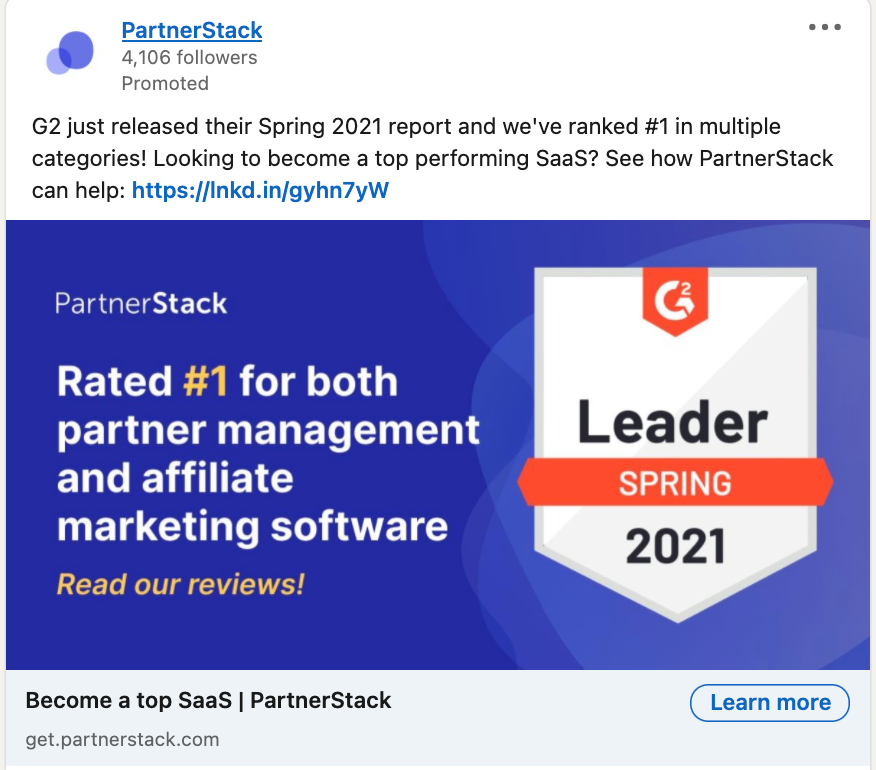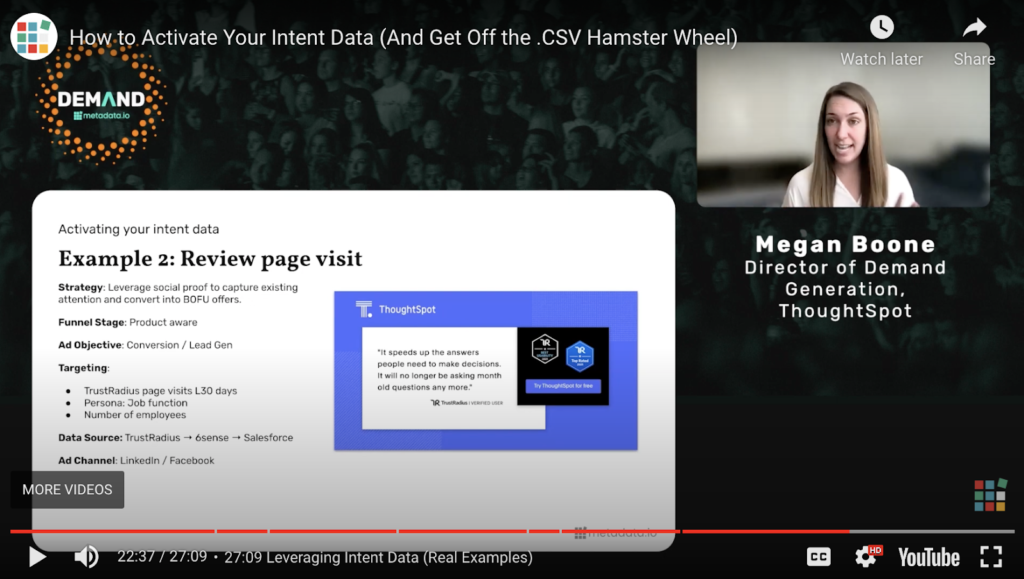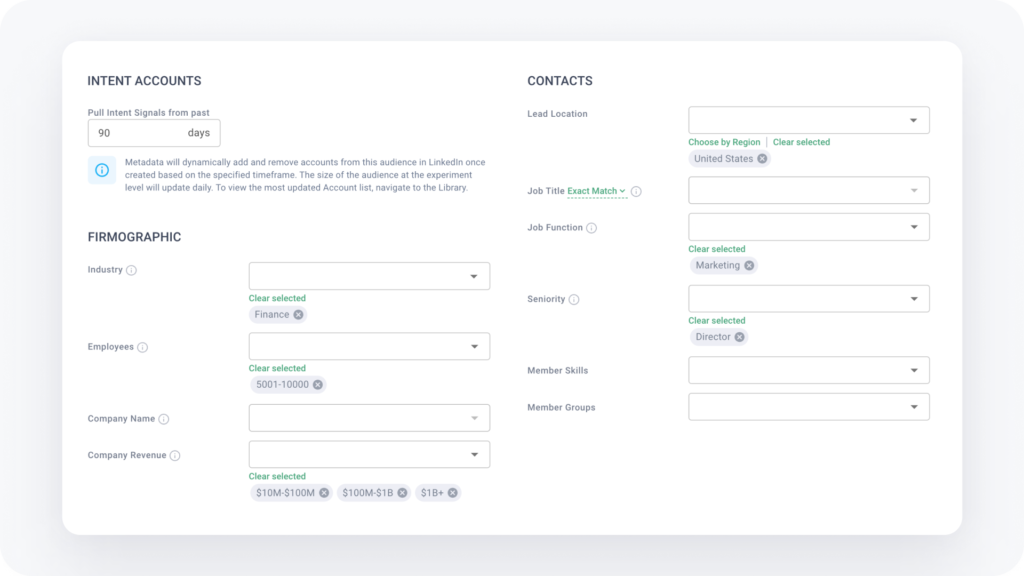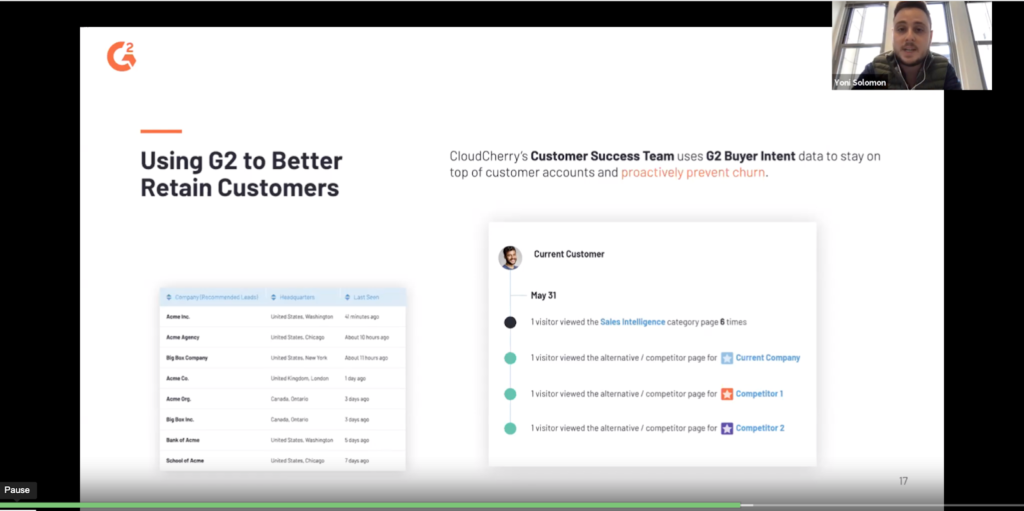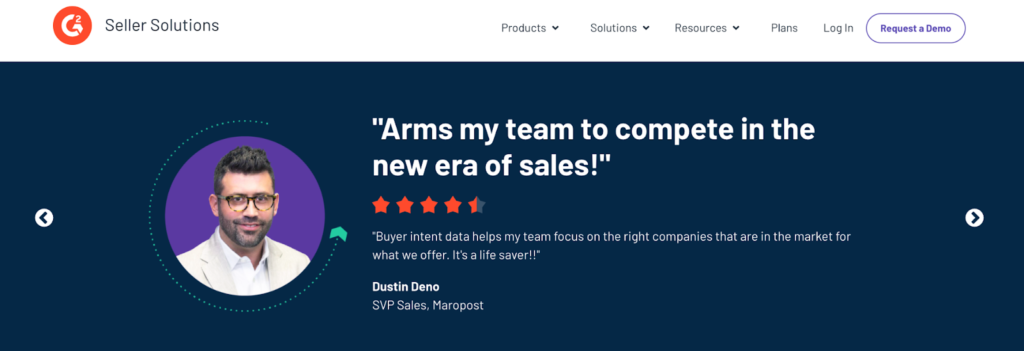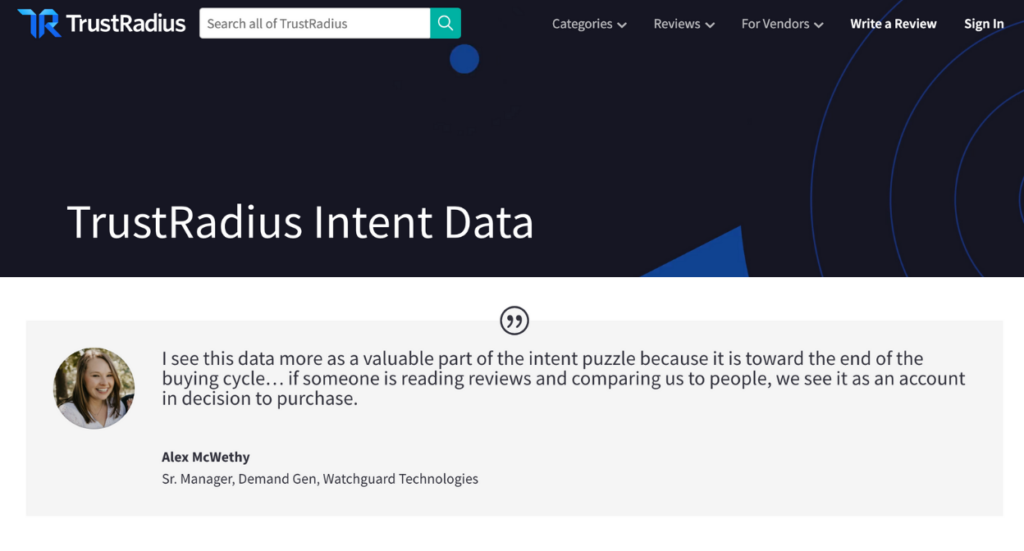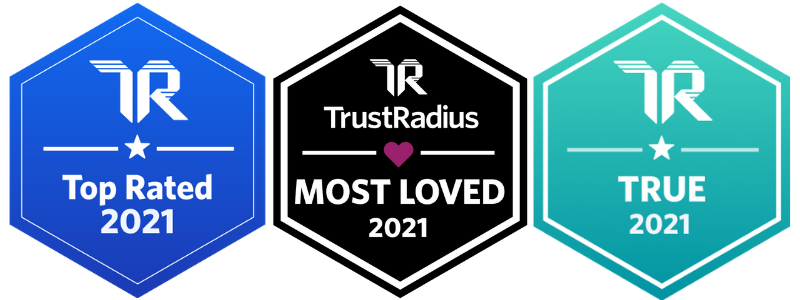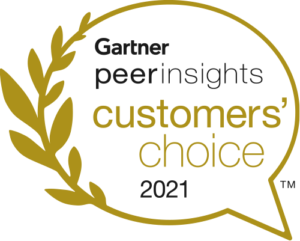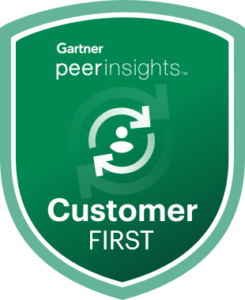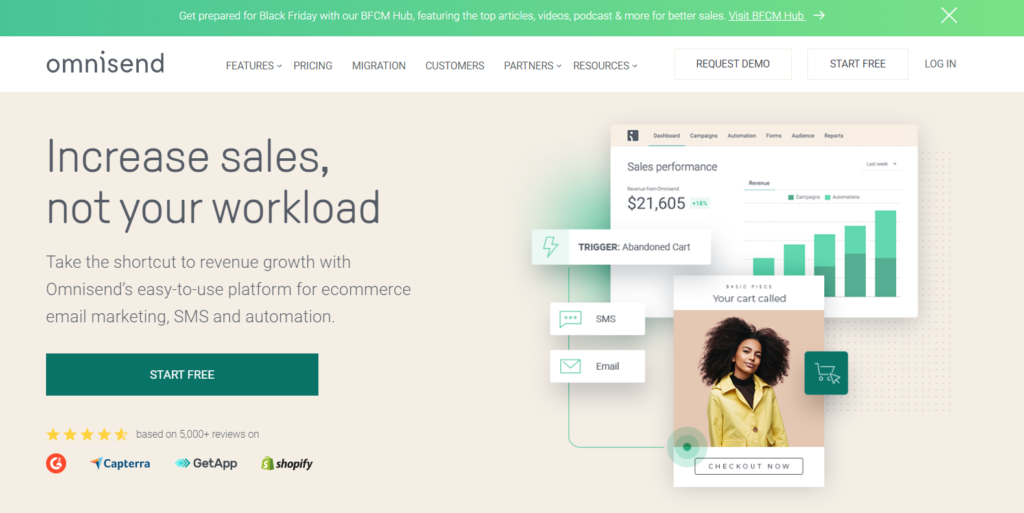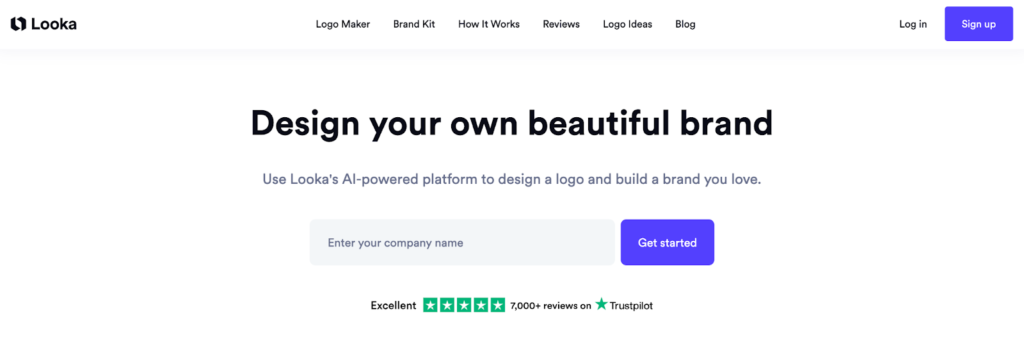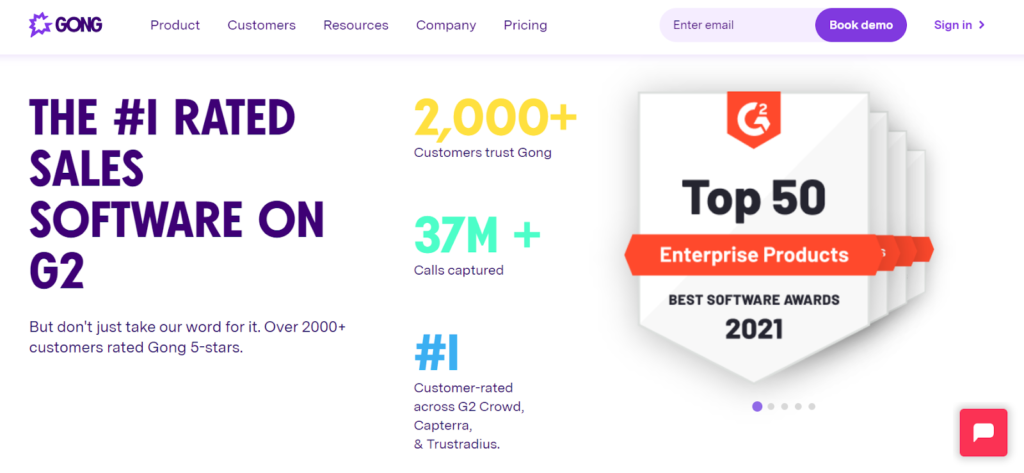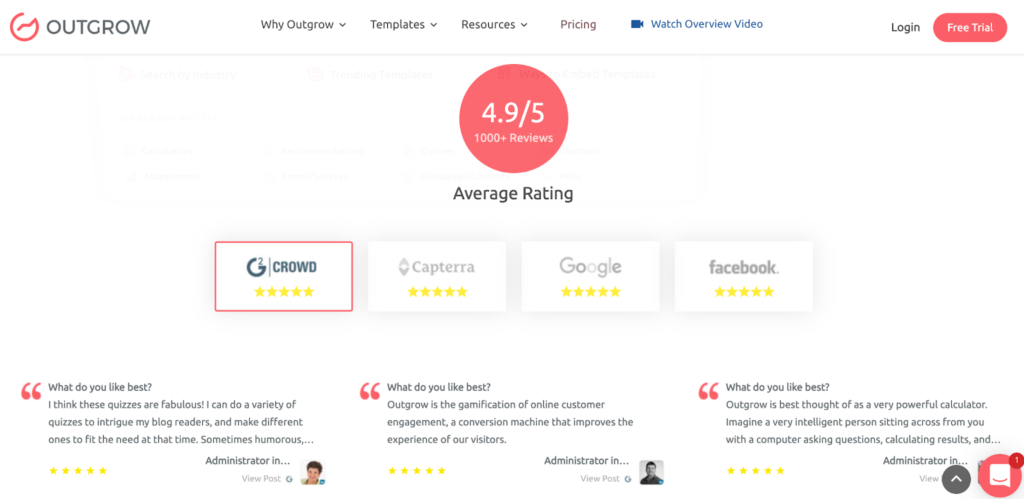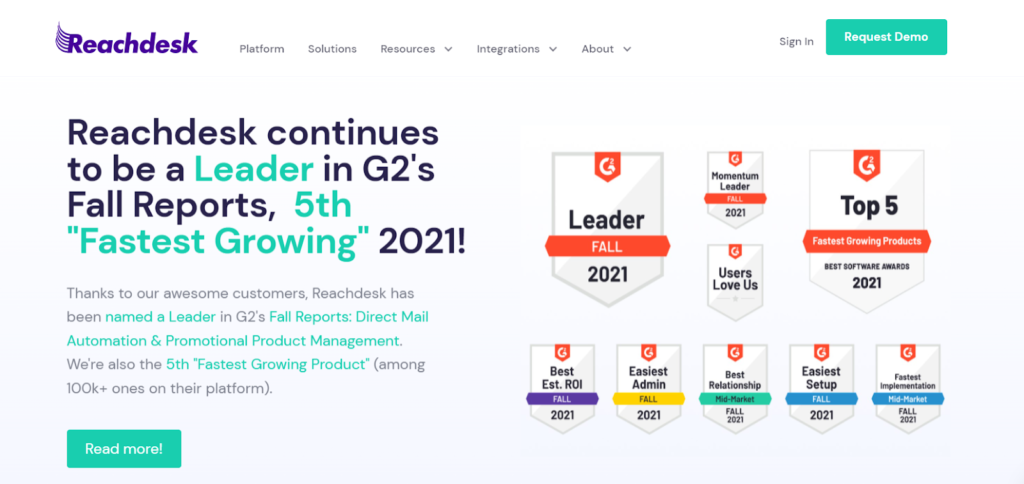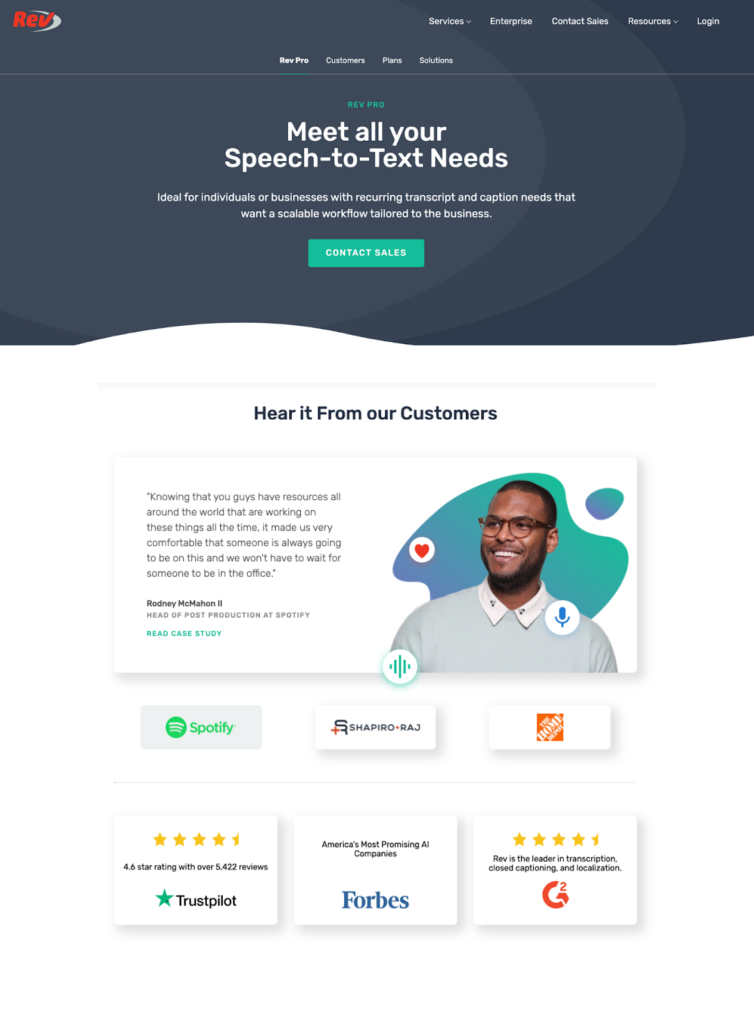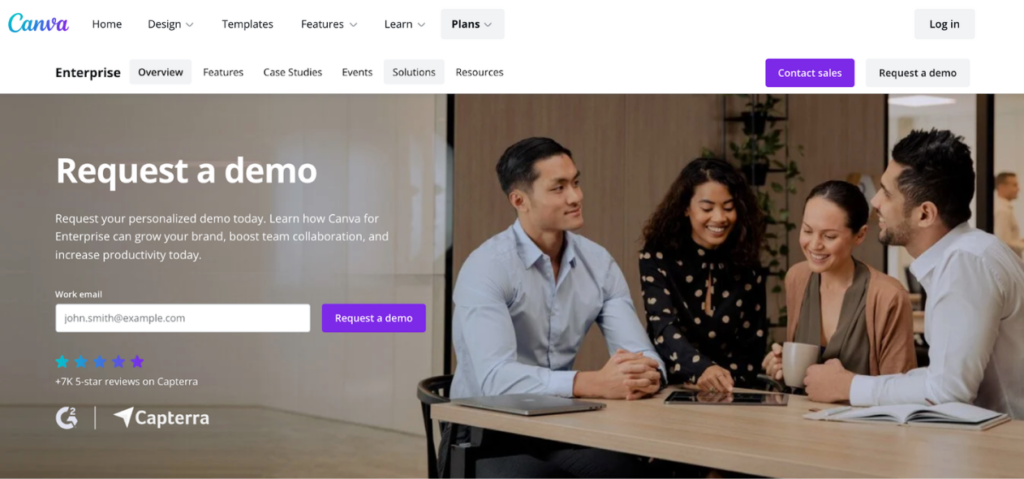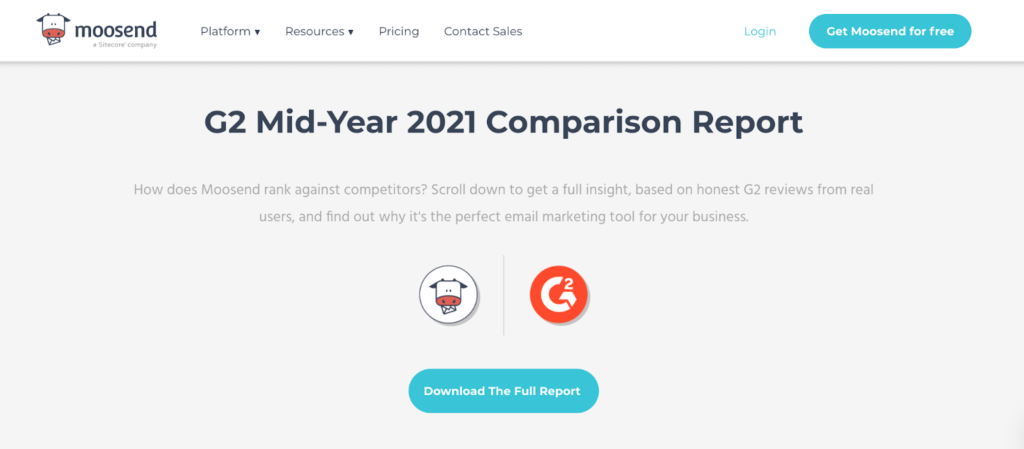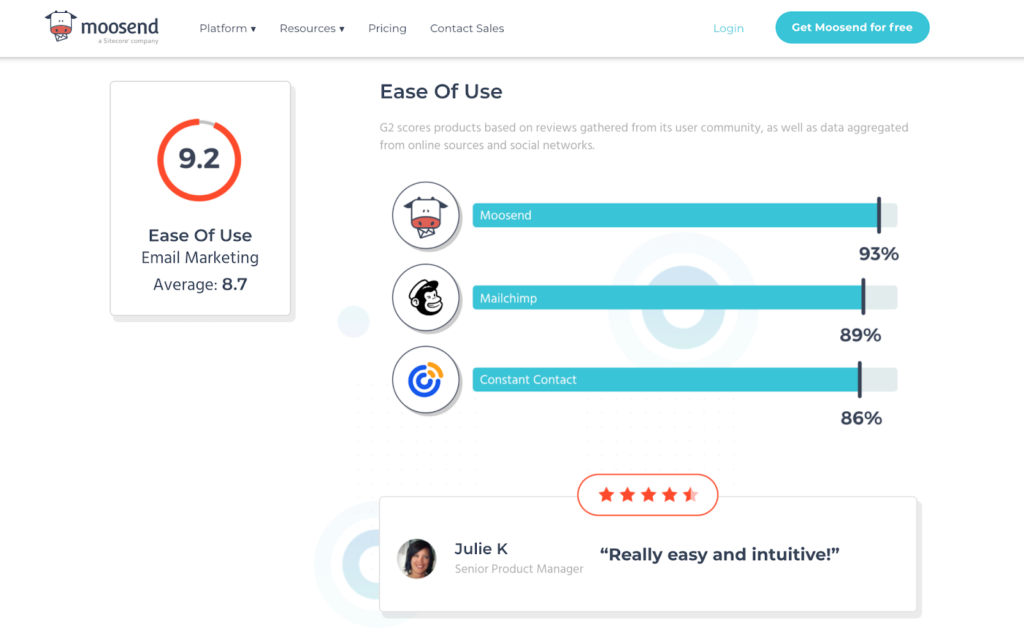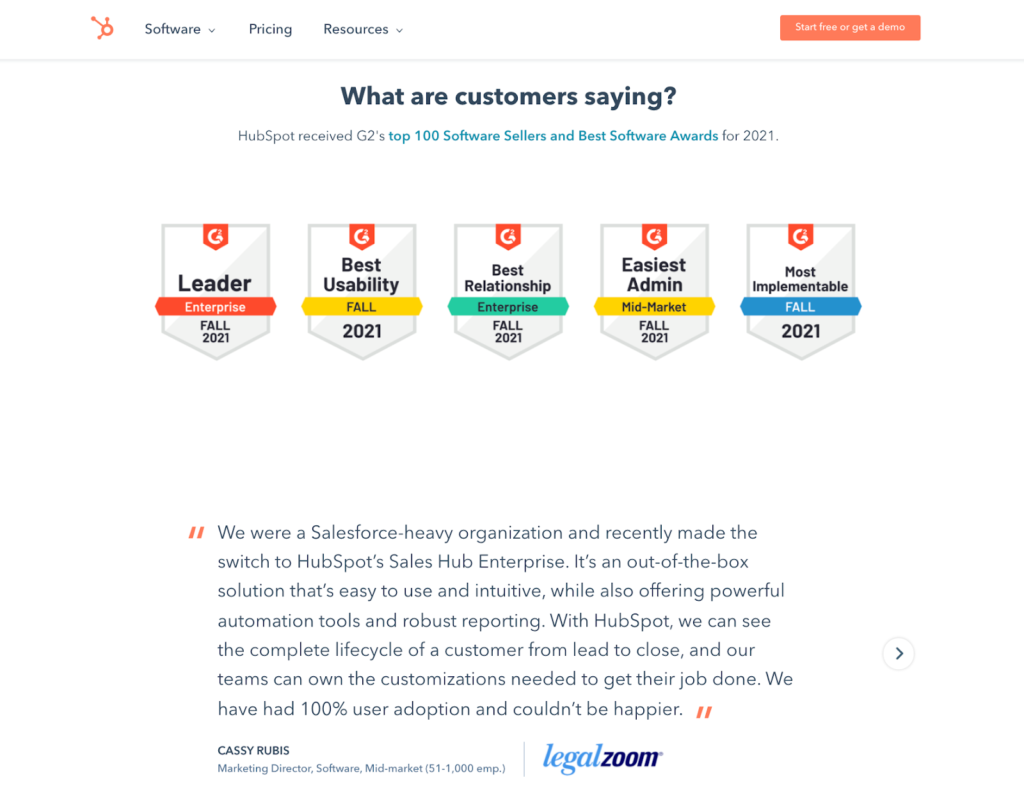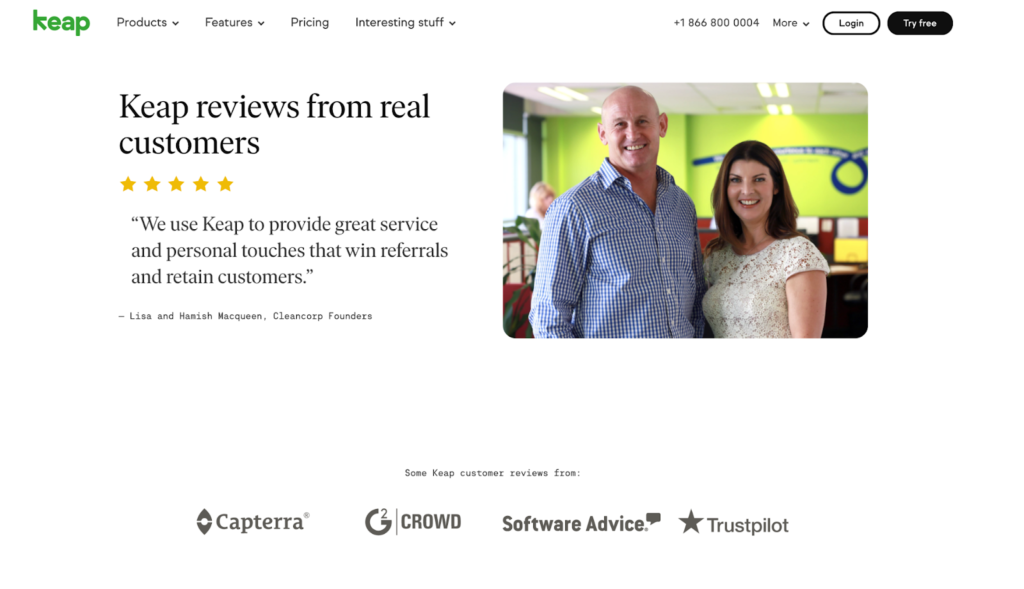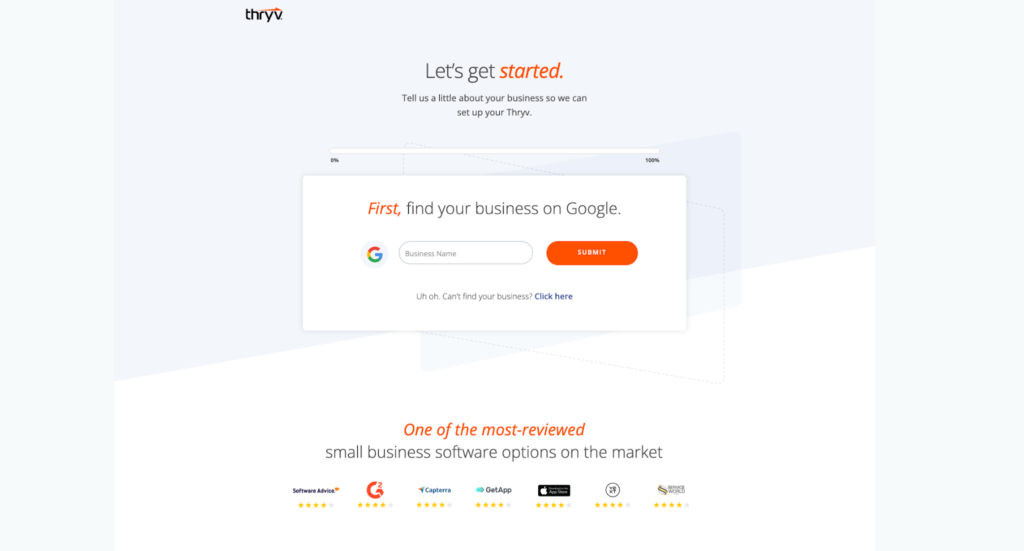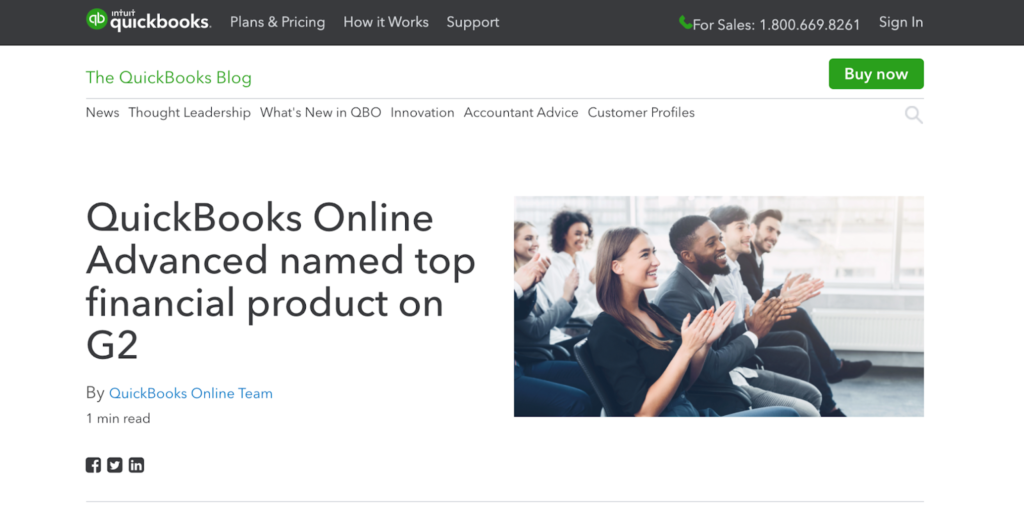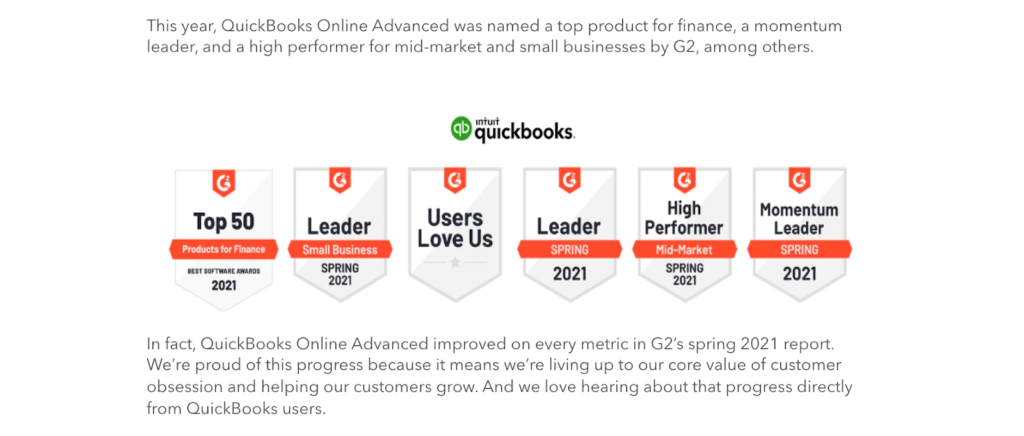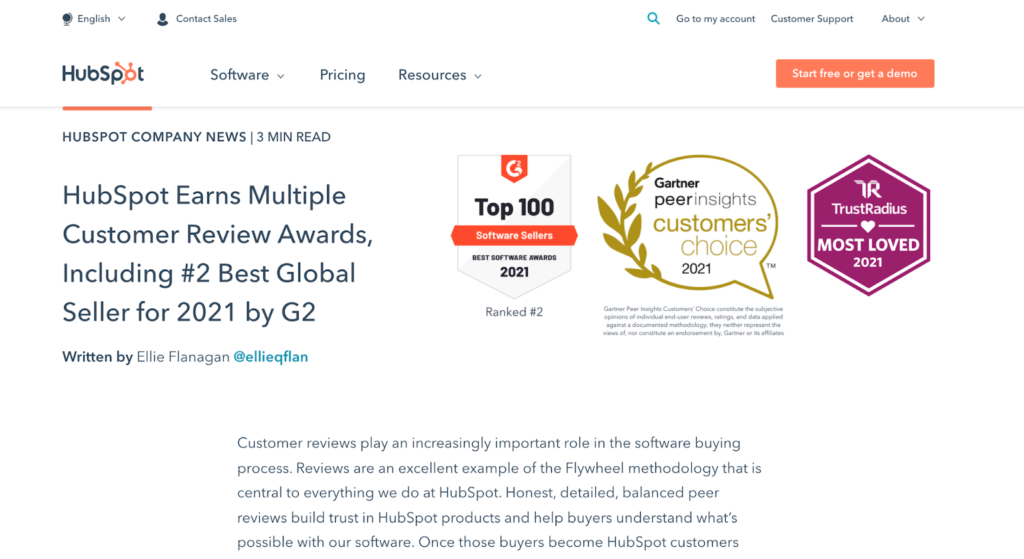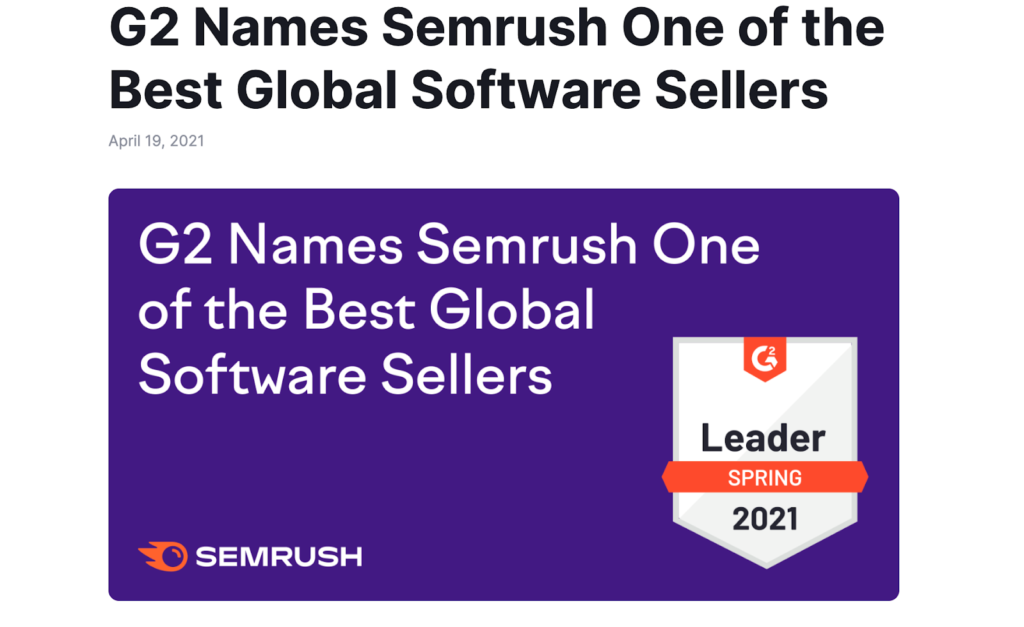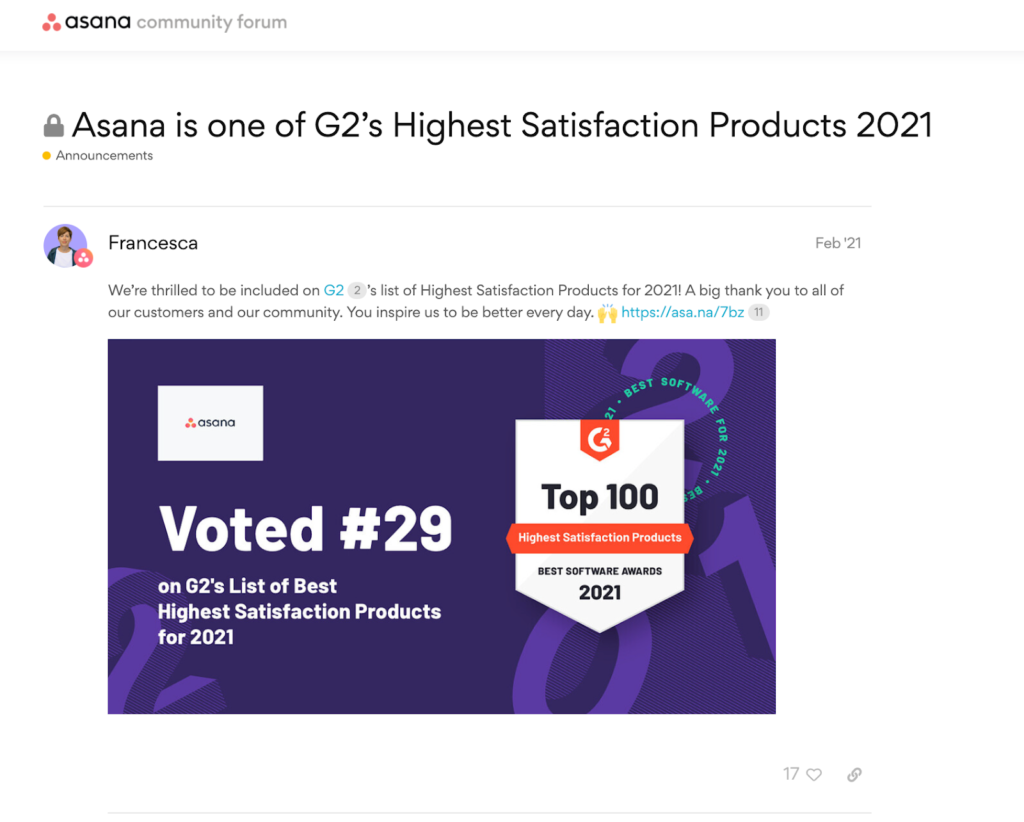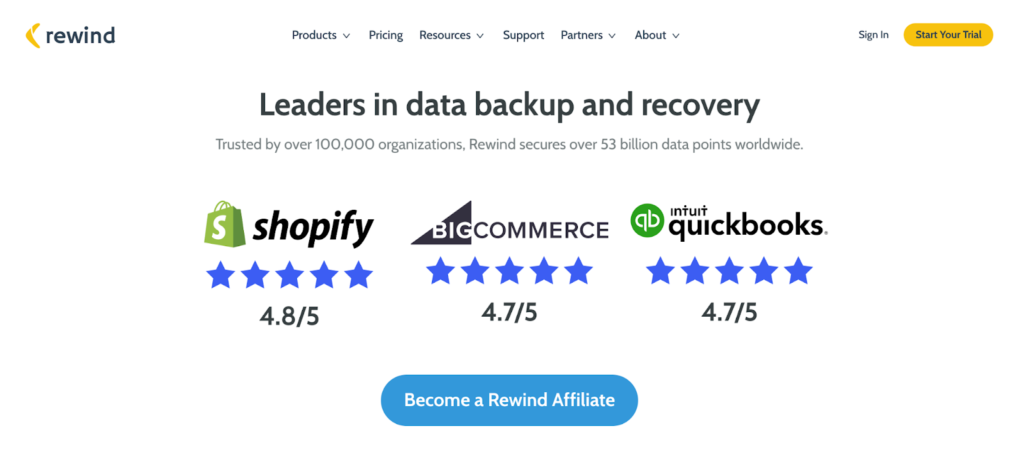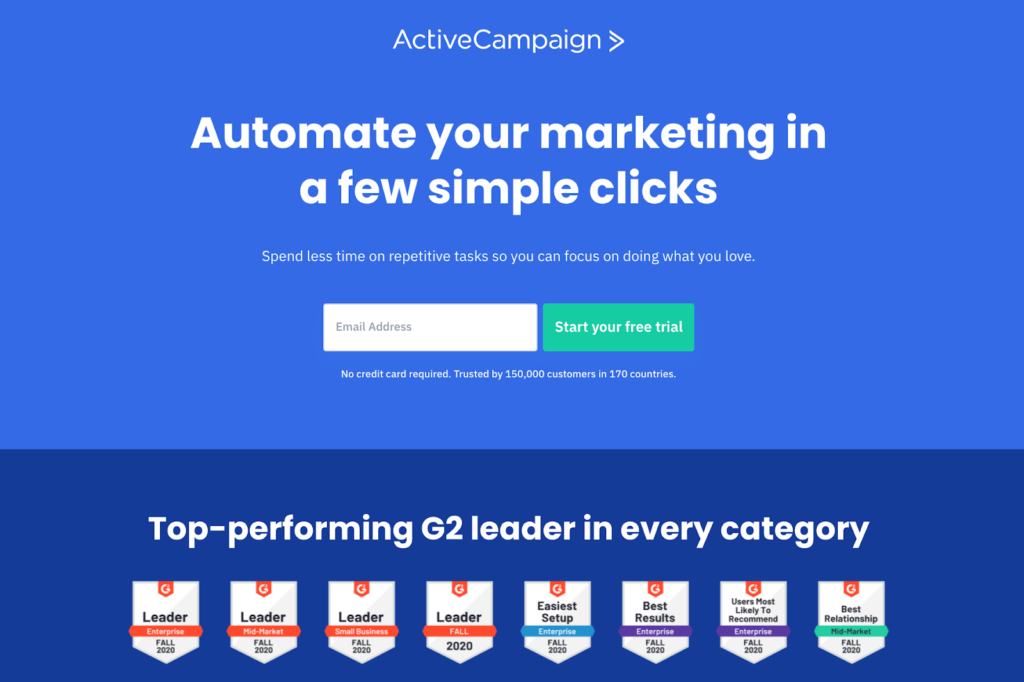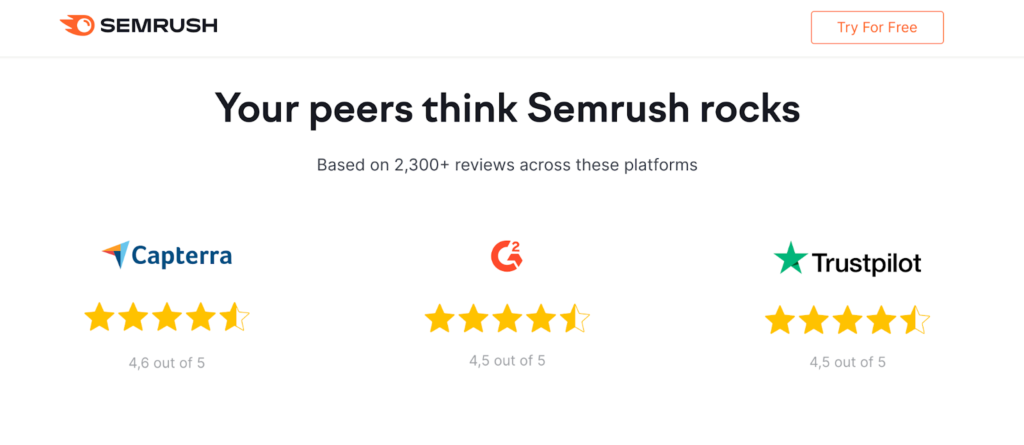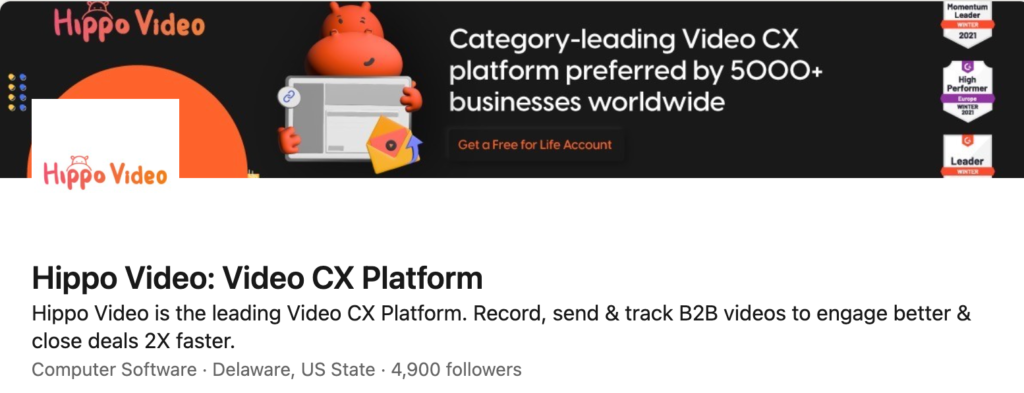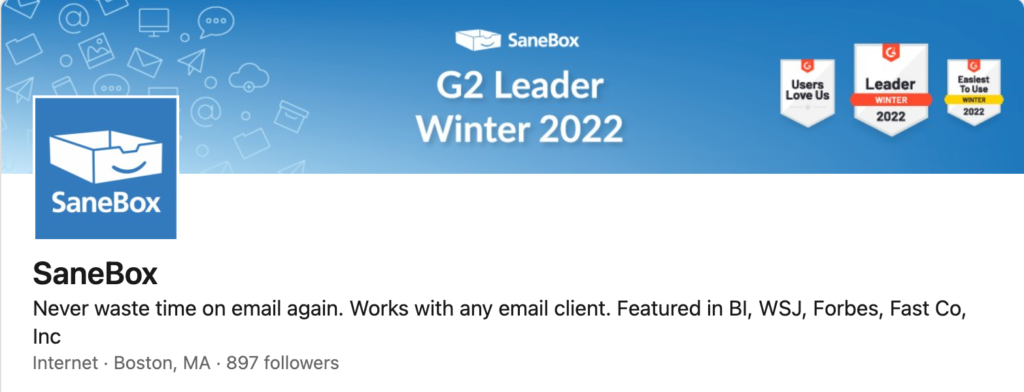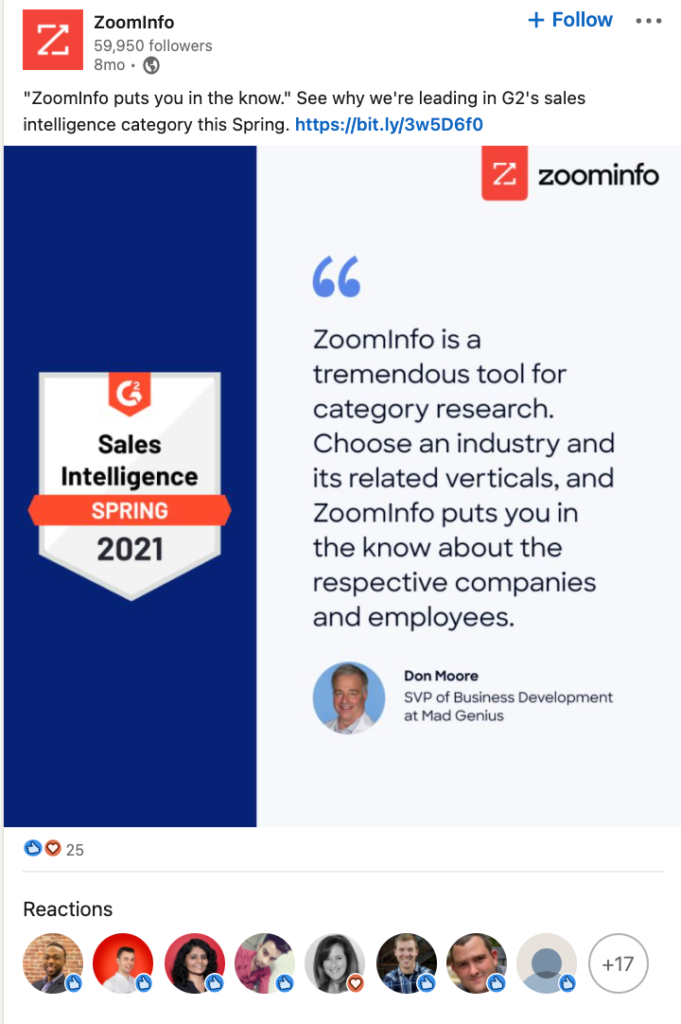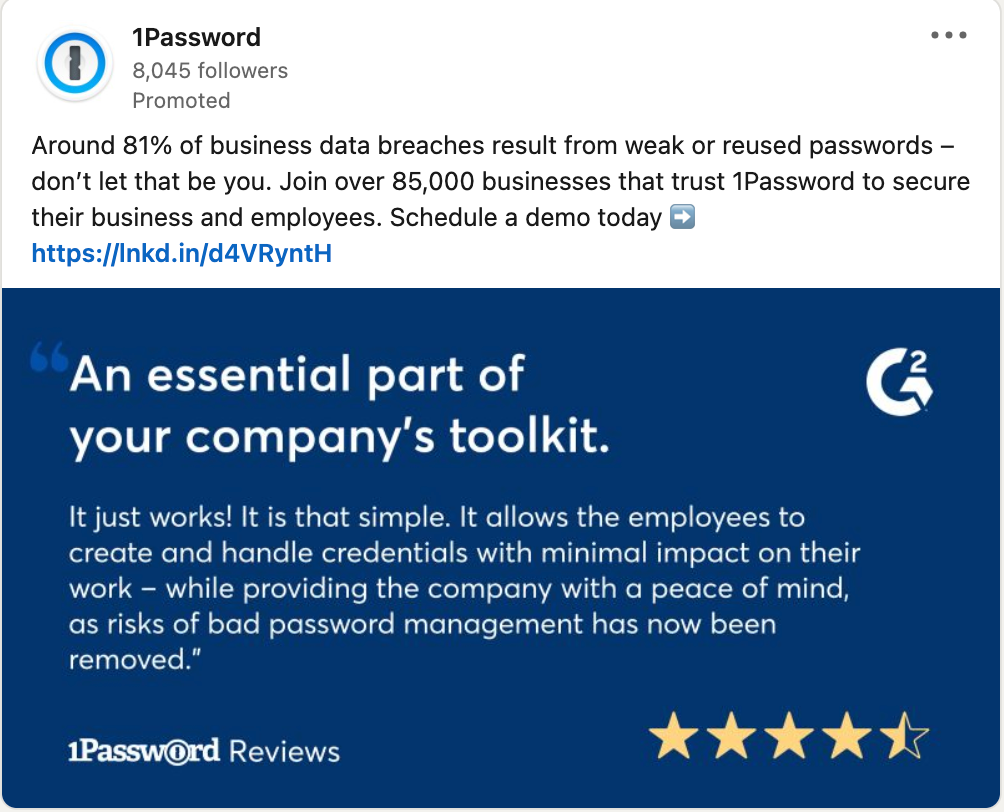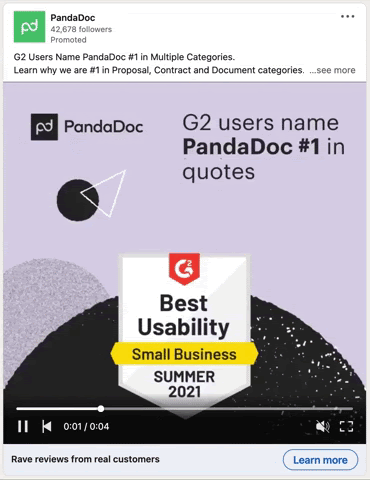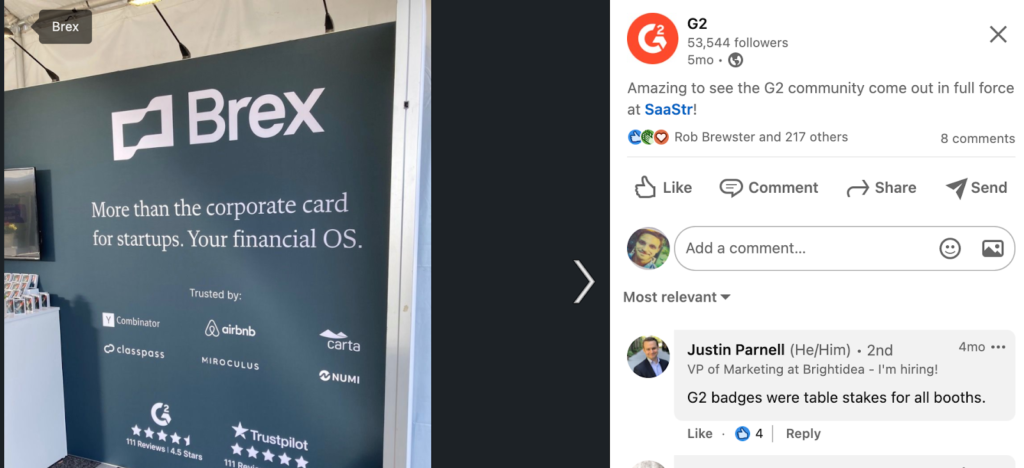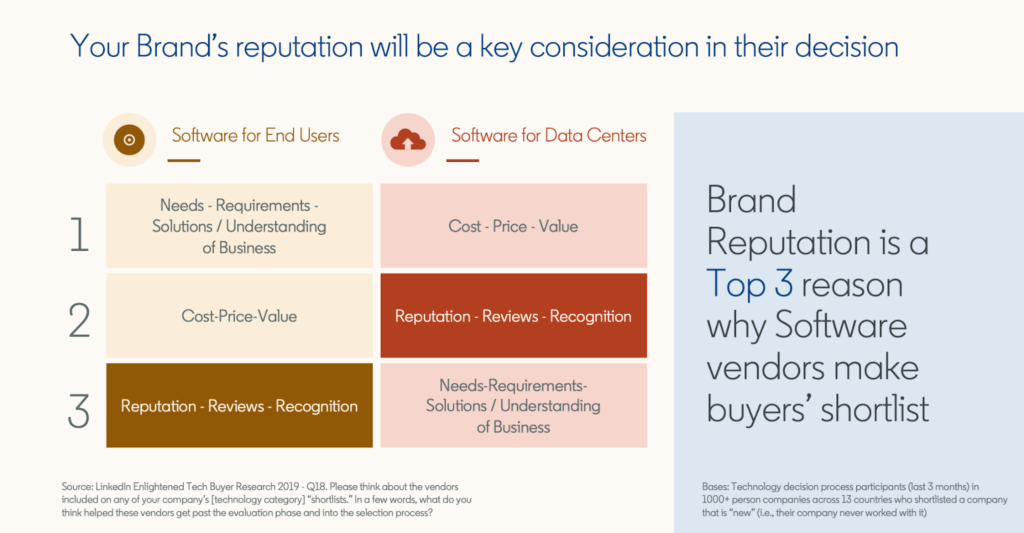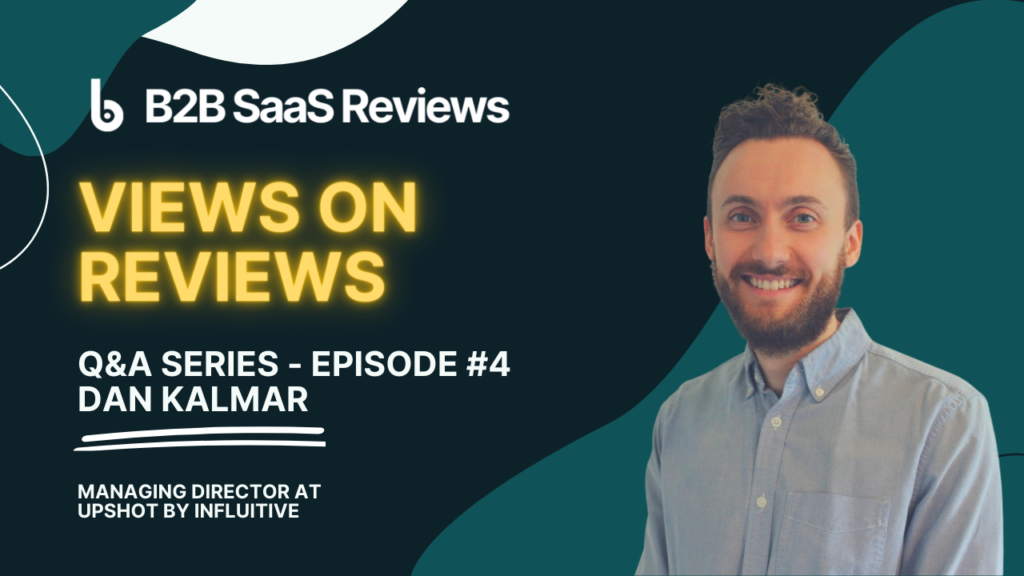After generating online reviews, here comes the fun part: how do you leverage online reviews in your B2B marketing and sales?
This post is a how-to guide on reviews for vendors in B2B SaaS with many examples of online reviews as social proof.
Table of Contents
How do you leverage online reviews in B2B marketing and sales?
Once you’ve done the hard part – getting reviews from your users and perhaps your company in a top spot on a review site – then comes the fun part: seeing which buyers are looking at your reviews and also sharing your customers’ voice and success both internally and externally.
Let’s start with seeing which buyers are looking at your reviews and how to take action based on that information.
Buyer intent – a modern addition to demand generation
One of the most powerful ways to leverage your reviews is buyer intent data.
G2 defines buyer intent data as “a set of signals or data points collected to indicate if someone is in the market to buy from you and where they are in the process.”
Gartner predicts that by the end of 2022, more than 70% of B2B marketers will use third-party intent data to target prospects or engage groups of buyers in selected accounts.
There are multiple sources of buyer intent. Review site PeerSpot (formerly known as IT Central Station) created a helpful diagram to show the different types of intent data and how they differ.
Buyer intent with review sites (or review platforms, as in the diagram) is essentially intel on which companies visit your review site software category pages, vendor profile pages, and competitor comparison pages. Suppose a visitor views any of these pages. In that case, they’re said to be displaying a sign of buyer intent because they’re behaving like a typical buyer: researching their software options by reading reviews.
Buyer intent is one of the hottest topics in demand gen. The rise of buyer intent is likely due to the ongoing shift in software buying behaviour to more online research. According to SiriusDecisons (now Forrester), 67% of the buyer’s journey is now done digitally. And Gartner predicts that 80% of B2B sales interactions between suppliers and buyers will occur in digital channels by 2025.
Forrester argues, “the standard is now higher for sales to add value to the conversation because (buyers can find) so much information online” and that “Marketers, your mission is to help sellers get engaged early with customers and prospects…”.
That’s where buyer intent data comes in. Not only to find and engage your buyers early in the buying process but also to know where many of them are in their buying journey. Knowing where your buyers are on their buying journey helps all go-to-market functions – Marketing, Sales and Customer Success – improve communication with their buyers. When vendors tailor their message to a buyer based on where they are in their buying process, this increases the likelihood that the vendor will engage the buyer and provide more value to them.
How to use buyer intent from B2B software review sites
All the major B2B software review sites now offer buyer intent as a service.
It’s probably the main reason why these review sites can provide a valuable free service to buyers while also providing vendors with enough value to get them to fund the site’s work.
One way to think about using buyer intent is by function: Marketing, Sales, and Customer Success.
Buyer intent for Marketing
Advertising is one of the primary uses of buyer intent by Marketing.
At PartnerStack, we use G2 buyer intent by leveraging the G2 integrations with HubSpot (our Marketing platform) and LinkedIn Matched Audiences.
With LinkedIn Matched Audiences, you can easily target those showing buyer intent on G2 with ads on LinkedIn.

For more details on one of your G2 buyer intent audience segments for LinkedIn Matched Audiences, you can change both the lookback window and the type of buyer intent behaviour. The lookback window is how far you want to go on the buyer intent behaviour (e.g. only those who have done so in the past 90 days). The four types of buyer intent behaviour you can select are:
- Researched your company’s G2 category (if you’re in more than one category, you can select which category or categories you’d like to include in the advanced filters)
- Researched alternatives to your company,
- Viewed your product (Company) profile on G2
- Compared your company/product to other products

At PartnerStack, we restructured our LinkedIn ad campaigns to be grouped by buyer engagement:
- Cold – no recorded buyer engagement
- Warm – G2 buyer intent, homepage visit, etc.
- Hot – high-value page visits (landing pages, pricing page, demo page, etc.)
- Spicy – active opportunities
We leverage G2 buyer intent the most at the “Warm” stage. Our main goal is to get these people to visit our site and request a demo (except for the Spicy ad group that is intended to help accelerate and win more opportunities).
Here’s an example of one sponsored update that we have promoted to our Warm audience of people showing signs of G2 buyer intent.
We also target this warm audience of those showing signs of G2 buyer intent with various ads: whitepapers, case studies, solution benefits, webinars, etc. But it’s a good idea to always include ad(s) that leverage G2 messaging, such as G2 badges, as social proof that ties back to the user’s behaviour.
Example: How ThoughtSpot is leveraging buyer intent for advertising
Megan Boone, Director of Demand Generation at ThoughtSpot, presented how to use review site buyer intent at Demand 2021 by Metadata.io. In her presentation, she shared these examples of how to use buyer intent to improve your targeting and messaging with ads.
The first example is leveraging buyer intent data of potential buyers who visit your review page profile to convert them to a bottom of funnel (BOFU) offer (in the ad example shown, that’s a free trial). You can layer on filters as you see fit, as Megan has done with the time range of last days for the buyer intent behaviour, job function to target the right people, and the number of employees to target the right sized companies.
The second example is similar to the first but with a slight twist: the buyer intent is on your software category pages, not your profile page. Megan defines these buyers as problem-aware but not product aware (at least not aware of her product).
She adjusts her approach based on this buyer’s intent (problem aware) to target them with an attention-grabbing piece of content that is her best bet to convert the potential buyer to the next stage (product aware), i.e. to consider their solution.
While in both examples, Megan is using an additional tool to connect the buyer intent from the review site to the ad platform, you don’t necessarily need the two tools she listed (6Sense and Metadata.io) to do it (though it would help if you did). You could use the G2 integration in a Marketing automation tool like HubSpot to connect the G2 buyer intent data as a dynamic list to Facebook, LinkedIn, and other platforms. Alternatively, you could download static lists of buyer intent from the review sites and upload these lists directly to Facebook, LinkedIn, etc.
For another example of how a B2B SaaS company can use buyer intent data, see how Chili Piper is leveraging G2 buyer intent data in Metadata.io to segment campaigns and focus on prospects most likely to convert.
Buyer Intent for Sales
Your Sales team can also leverage buyer intent.
As Reachdesk CRO and Co-Founder Alex Olley said of using third-party intent data, “The real challenge is how you enable the sales team to engage in a meaningful way once you’ve seen those buying signals. Marrying intent data with the right sales enablement tools is vital. Unless you’re evolving your approach all the time, the data you collect is going to waste.”
To enable Sales to use buyer intent effectively, find a way to get them the buyer intent information on accounts assigned to them or accounts that they can work.
At PartnerStack, we leverage an app called Rattle (similar to Troops.ai) that integrates our G2 buyer intent with our Salesforce and Slack so that we can automatically provide Slack updates like this one that pulls account owner information into the Slack message to tag and alerts the Sales rep of the intent, and provide them with helpful context on the intent to understand the account’s buying intent better.
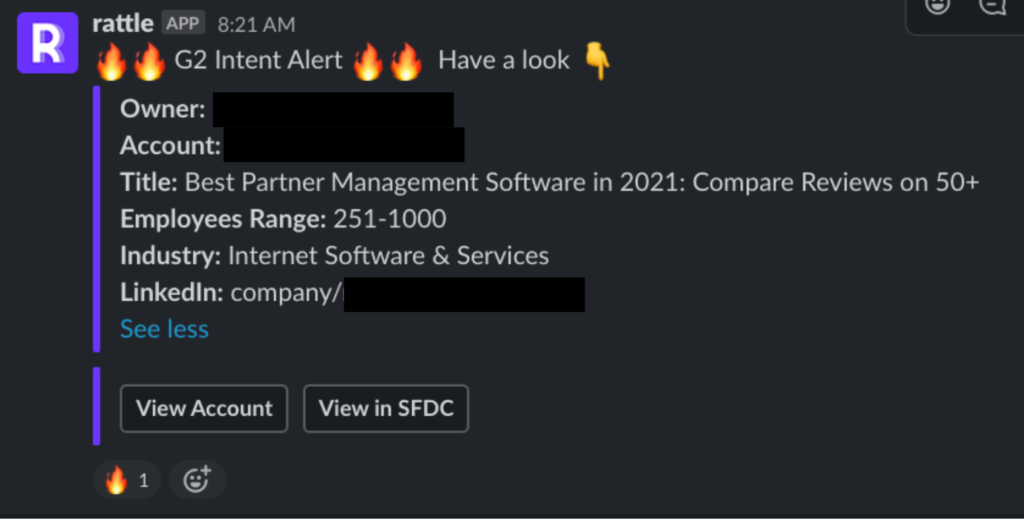
At PartnerStack, we also tailor G2 Salesforce reports of buyer intent for each rep, so they have one place to go to see all of the G2 buyer intent on their accounts. As you can see in the screenshot, the report includes the type of buyer intent / G2 pages visited by people at an account, when the visit occurred, etc.

Buyer intent alerts for Sales will help them reach out to more in-market accounts and also help improve the relevancy of Sales’ outreach message to the account.
Buyer Intent for Customer Success
Beyond Sales and Marketing, your Customer Success team can proactively leverage buyer intent to prevent churn and proactively increase renewal rates.
G2 discusses this use case on its blog and webinars like the screenshot.
When your current customers are showing signs of buyer intent by visiting your software category pages, your product profile, and comparing you to your competitors, it may be a sign that they’re looking into alternatives.
When one of your customers shows signs of buyer intent, you can alert one of your Customer Success Managers of it to reach out to see how they can help.
At PartnerStack, here’s an example of buyer intent from one of our larger customers. You can see an automated Slack message to our inbound-g2 Slack channel. In the Slack message, the Customer Success rep on the account is automatically tagged and alerted, and they can see the type of buyer intent (confidential information concealed).
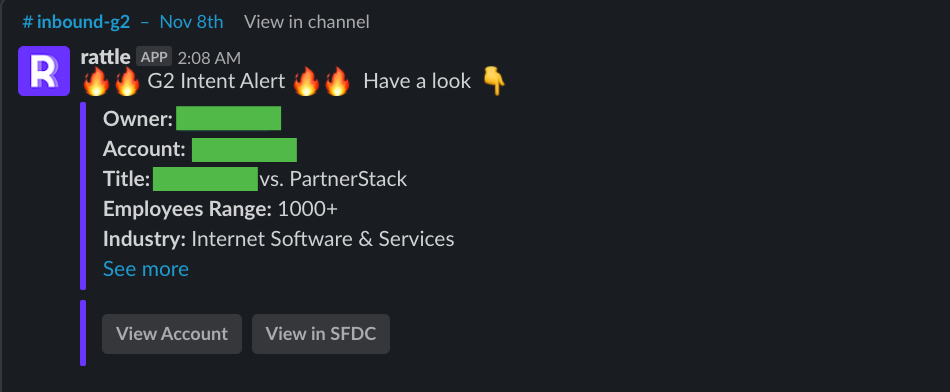
Whether buyer intent is used for Sales, Marketing, or Customer Success, for many B2B SaaS vendors, it only takes one new customer or one saved customer to pay for a buyer intent subscription. When you leverage buyer intent across all three functions, you increase the return on your investment. For many in Demand Gen, layering buyer intent on top of lead-gen is a must to hit your growth targets.
For more how-to information on buyer intent, please see these resources from business software review sites:
- G2’s The Buyer Intent Playbook: How to Make the Most of Intent Data and G2 Presents: Your Guide to Buyer Intent (on G2)
- TrustRadius’s The 2021 Ultimate Guide to B2B Intent Data
- Gartner Digital Markets’ 3 Best Practices for Using Third-Party B2B Buyer Intent Data in ABM and Achieve More With Buyer Intent
- PeerSpot’s The Essential Guide to Review Platform Intent Data
For more information on buyer intent data solutions, see these solutions from G2, Gartner Digital Markets, TrustRadius, and PeerSpot.
Internal communication on review site achievements
When I started working on generating reviews for business software companies, I hadn’t considered the impact reviews could have on internal communication. Now I see it as an integral part of review management.
Getting user feedback is valuable for many people across a B2B SaaS org.
Even better, when you generate reviews from your happy users and earn a top spot on review sites, it creates social proof that can validate all the hard work that employees are doing day in and day out and act as a reminder to celebrate customer success together as a group.
You may even see a boost in employee NPS, retention, and recruitment with strong review site positioning.
As you can see in this internal Slack announcement message, these types of posts tend to get a lot of love in the way of emojis (one indicator of performance in B2B SaaS internal communication :).
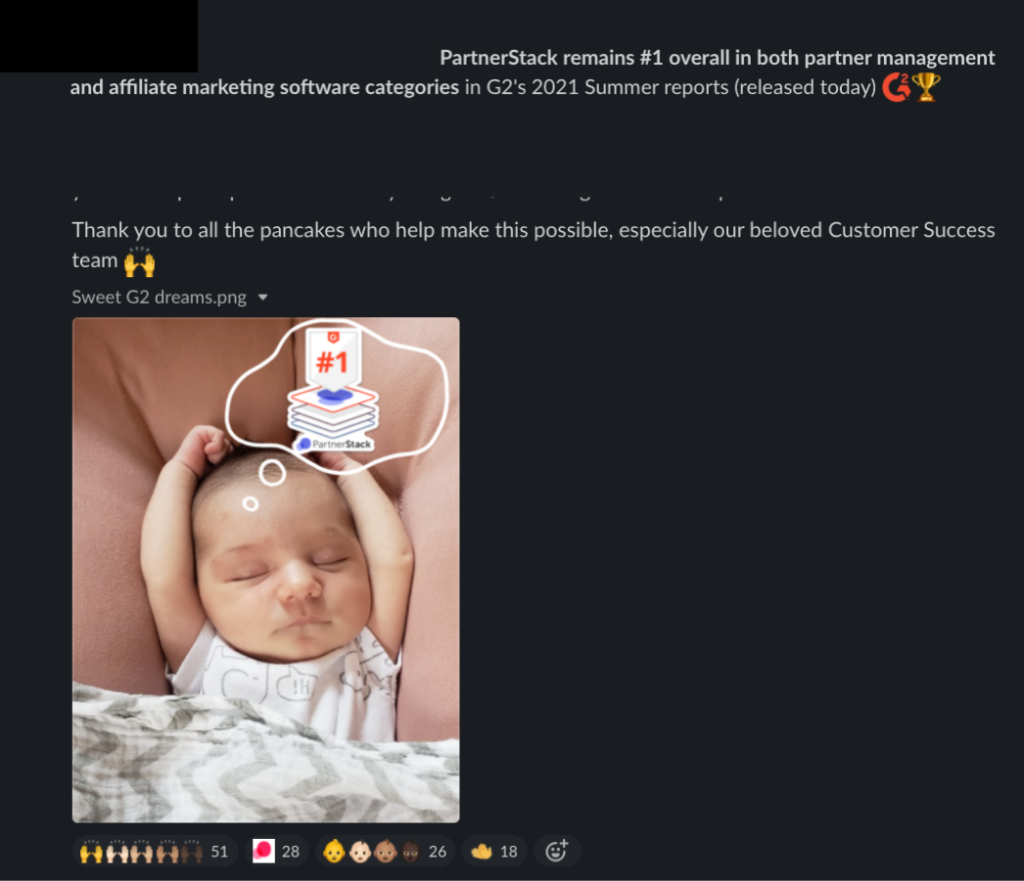
In my experience, founders and execs in particular love these internal announcements of review site achievements. These achievements are a testament to the work of every employee at the company, and the internal communications about them are a great way to bring together employees from across the organization to celebrate together.
External communication: review site achievements as social proof
We often look to others to know what to do when in doubt.
Companies that demonstrate the norm to their audience reduce doubt by utilizing social proof, one of seven principles of persuasion defined by influential psychologist and marketer Robert Cialdini.
“Social proof is considered prominent in ambiguous social situations where people are unable to determine the appropriate mode of behaviour, and is driven by the assumption that the surrounding people possess more knowledge about the current situation.”
One experiment that exemplifies social proof was conducted by researchers who joined a door-to-door charity campaign and found that if a list of previous donors was longer, the next person solicited was more likely to donate.
The findings have been similar in purchase decisions. B2B SaaS buyers need to make difficult decisions that cause many of them to have feelings of uncertainty and doubt. The more that a software vendor can do to show a prospective buyer that the other buyers who have come before them are many and are satisfied.
For example, B2B SaaS growth agency Powered By Search supported their homepage header and call-to-action with recent client wins (as social proof) and saw conversation rates “increase greatly.” They applied the learning with a client and saw a 9.9% increase. Tara Robertson, Sr. Demand Gen Manager at Chili Piper, also tested recent client wins as social proof and saw a 10% increase in web conversions.
Couple months ago, I added client wins to our homepage and saw conversion rates increase greatly
— Marc Thomas (@iammarcthomas) July 28, 2021
We reused the tactic for a client of ours and they saw a 9.9% increase in demo close rate
This was the only change pic.twitter.com/FOVsB5GFlS
That’s why SaaS companies like Sprout Social (Social Media Management) wrote about the merits of testimonials and reviews and the awards and accolades that come from those reviews (with examples of reviews as social proof).
Mike Sonders, a Digital Marketing Consultant in B2B SaaS, has also advocated for leveraging reviews as a SaaS website best practice for brands in competitive industries (i.e. most of SaaS):
“In competitive industries, search results for “[brand] reviews” are dominated by the big review-aggregation sites like G2, Capterra, and TrustRadius. That’s why it’s so important for SaaS brands to monitor and (ethically) manage the reviews on those sites. In turn, you can use your reviews from those third-party sites as social proof on your marketing pages.”
Unbounce (Landing Page Builder Software) has also written about using social proof to drive more conversions. In a now-classic presentation by Angie Schottmuller at Unbounce, she illustrated six uses of social proof that she called the 6Ss of social proof.
As you can see, companies can use reviews as social proof in any form of the 6Ss:
- Score it – use a review site rating e.g. “users rate us a 9.5 out of 10 in ease of use.”
- Sum it -use a reviews count e.g. “see our 300+ reviews.”
- Say it – use a review quote. e.g. “I love this software because of X, Y, and Z.”
- Sign it – use a review site logo e.g. combine review site logos like G2 and Capterra with actual reviews.
- Show it – use a video review e.g. couple a written review with a video review or photo of the reviewer.
- Shine it – use a review site badges e.g. a Leader or Top Rated badge.
Given the many ways that companies can use reviews as social proof, let’s go through how you can earn award site badges and apply them along with other uses of reviews as social proof.
How to earn a badge on a B2B review site
To earn a badge on a review site like G2 or Capterra, you typically need to generate a minimum number of reviews in a time frame and generally outperform the competition to some extent (you don’t need to be #1, but you need to be amongst the top ranks).
G2 Trust badges
According to G2, 47% of consumers said that trust logos reassure them a site is trustworthy.
G2 seems to operate on a need-to-know basis with G2 trust badges, providing badges with an explanation of how you, the seller, earned a badge after you have earned it.
For example, what could be called the “entry-level” G2 badge is the “Users Love Us” badge, which companies earn “after collecting 20 reviews with an average rating of 4.0 stars” (from my.G2)
In the G2 Admin portal, the “Learn more about G2 Badges” link is to the G2 support page for “How can I use the G2 Badges section,” which tells you how to know which badges you’ve collected and how to use them.
Example G2 badges include but are not limited to:
- Leader – Products in the Leader quadrant in the Grid® Report are rated highly by G2 users and have substantial Satisfaction and Market Presence scores
- Best Usability – The Best Usability product in the Usability Index earned the highest Usability rating in its category
- Best Relationship – The Best Relationship product in the Relationship Index earned the highest Relationship rating in its category
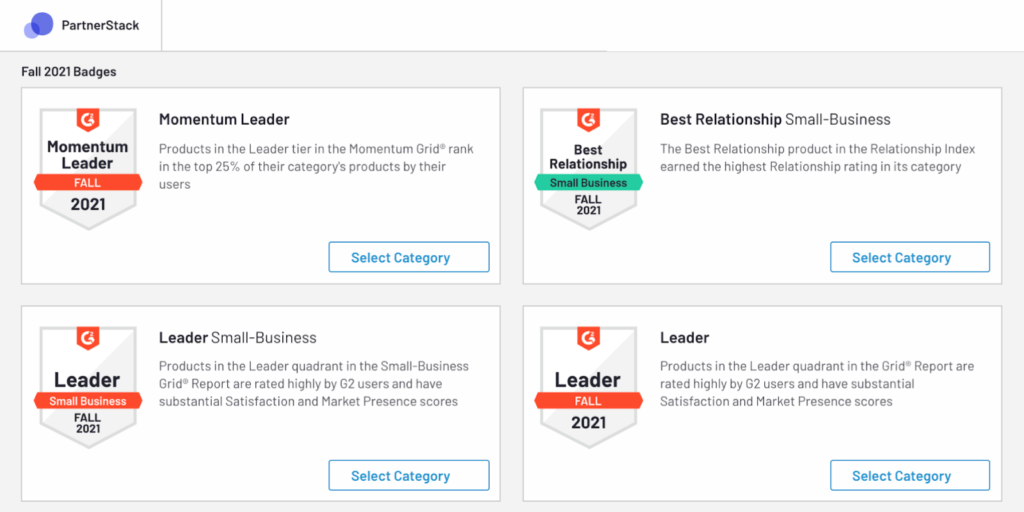
G2 also awards badges for their annual Best Software Awards. There are more than a dozen categories, such as Best (Overall) Software Products and Highest Satisfaction Products. Here’s an example of the Top 100 Fastest Growing Products badge in a LinkedIn post for PartnerStack.
As G2 says in the G2 admin portal, “Sellers love using G2 badges to let buyers (and the world) know how customers feel about their solution”.
And G2 loves sellers using badges, too, because not only does it provide G2 with free advertising, but also G2’s content usage guidelines state that you, the seller, may “republish the badge on your website, provided that it contains a backlink to the G2 page for your product or service.” Backlinks are a crucial component of SEO, so all these backlinks to G2 increase G2’s domain authority, which increases its dominance on search results.
TrustRadius badges
TrustRadius also awards badges, such as:
For more on promoting these software review sites’ award badges, check out TrustRadius’s “An Official Guide to Promoting Awards From TrustRadius.”
Gartner Digital Markets Badges
Gartner Digital Markets is newer to awarding badges, but they now award badges across each of their properties.
See these two pages for Gartner Digital Markets (Capterra, GetApp, and Software Advice): GDM research reports and their methodology page.
Other review site badges
While there are likely many other badges, here are a few other examples to note by Gartner Peer Insights and PeerSpot (formerly IT Central Station)
How to use review site badges
There are many ways to use the badges you earn on review sites. Let’s go through them and see examples of each.
On your website
Placing review site badges on websites is a popular form of social proof on B2B SaaS sites. It’s an easy way to show your website visitors that you have happy customers.
There are several familiar places where companies place review site badges.
On the Homepage – Supporting the main call-to-action
The most prominent place where you can put review site social proof is in the hero section of your homepage. Here are examples of B2B SaaS companies that have used review site badges in this way.
Omnisend (Marketing Automation Software for eCommerce) uses four review site logos, their aggregate star rating, and the number of reviews as social proof to encourage more visitors to take the call-to-action to start free (trial). While Shopify is not a review site (of course), they do have reviews. Omnisend also has a reviews page that features reviews from all four sites. Omnisend also appears to be A/B testing the homepage with and without the review site social proof, a good test for any B2B SaaS company.
ClickUp (Project Management Software) uses review site social proof similar to that of Omnisend: on the homepage under the call-to-action (CTA) to support it. It’s an everyday use case because the CTA to get started is well supported by the social proof of the thousands of other happy ClickUp users.
Looka (Logo and brand kit maker software) uses ratings and reviews as social proof to support its primary call to action. Trustpilot is a good fit for Looka’s primary audience of small business owners.
On the Homepage – Strengthening the page as a standalone section.
Gong (Sales Intelligence Software) has a section on its homepage to highlight its leading market position on G2 and other review sites. As the #1 overall software on G2 in 2021, they lean on G2 heavily in this section.
Gong also features a TrustRadius Top Rated badge to support their “#1 rated sales software on the planet” message (their rating across the universe remains unknown 😉).
Sprout Social (Social Media Management Software) builds trust on its homepage right below the fold with a section that features its accomplishments on three review sites: G2, Capterra, and TrustRadius. They also have supporting copy that speaks to some of their particularly well-rated areas to strengthen the message.
Outgrow (Interactive Content Software, such as calculators, quizzes, and assessments) has fittingly built an interactive reviews section on their homepage that allows the visitor to select their review site of interest and then read review snippets from that site (with links available to read the full reviews on the review site). Outgrow also shows scores and sums its review site data (4.9 rating on 1,000+ reviews).
Reachdesk (Direct Mail software) has a section on their homepage to showcase their many impressive G2 badge achievements.
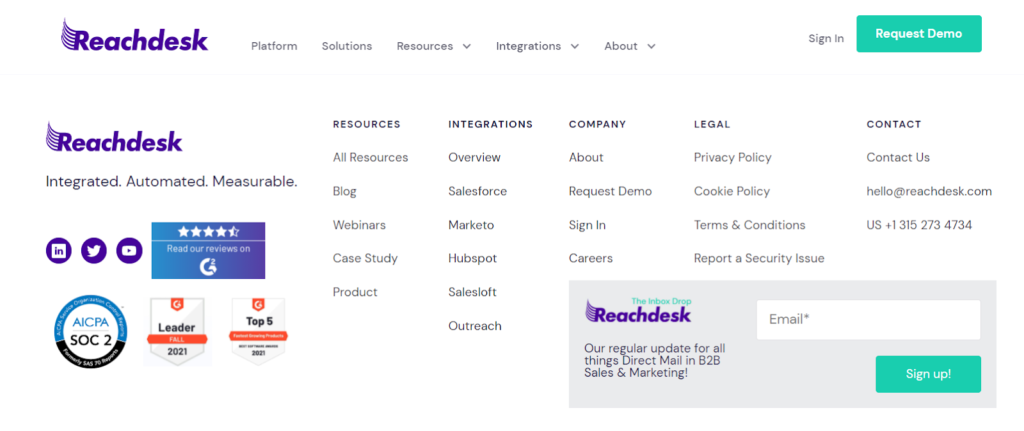
Reachdesk also uses G2 badges and review ratings as social proof in their footer alongside their security trust element (SOC 2 certification) and social media profiles.
Hunter (Professional email address finder software) uses their ratings on four review sites, including Chrome Web Store (for web browser apps), as a section on its homepage. They prominently highlight their review ratings on each site.
Favro (Project Management Software) designed its “Users 💜 us” section to feature G2 badges that scroll on the page in four vertical lines, each moving at a different speed, to eye-catching and Frogger-the-game-like effect.
On an Enterprise page – Supporting bigger purchase decisions
For SaaS companies that can serve both individuals and companies, there’s often a page called “Enterprise” that speaks specifically to the company-wide use case. For these types of SaaS companies, it is on these Enterprise pages that you’ll often see review site social proof, as seen in these examples.
Rev (Audio & video to text transcription software) services everything from one-off tasks for individuals to major transcription projects for large companies like Home Depot and Spotify. Rev’s enterprise page adds Trustpilot and G2 review site content – ratings, review counts, and a statement on leading multiple G2 categories (Transcription, Closed Captioning, and Localization) – as social proof to strengthen their “Hear it From our Customers” section. Rev couples this review site social proof with recognition from Forbes as one of “America’s Most Promising AI Companies”; a compelling combination.
Canva (Design software) uses G2 and Capterra logos and the number of 5-star Canva reviews as social proof to support their demo request call-to-action (CTA) on their Enterprise page.
On a Comparison page – Supporting how the vendor rates on a review site versus the competition.
Moosend (email marketing software and marketing automation) does a great job of taking the data found in quarterly G2 reports and turning it into a compelling comparison report and webpage. Moosend uses this data to compare Sendinblue, Mailchimp, Constant Contact, ConvertKit, Campaign Monitor, Omnisend, and DotDigital. Note: (this approach would require a G2 Content subscription as per G2’s Content Usage Guidelines)
HubSpot (all-in-one software for go-to-market) has more than a competitor comparison page; it has a comparisons library with 30 software comparison pages at the time of writing, each with review site social proof to support their comparison.
For example, on the Salesforce vs. HubSpot comparison page, HubSpot leverages G2 badges and selects reviews on the Salesforce vs. HubSpot comparison page to leverage the customer voice on why HubSpot over Salesforce. They use reviews as social proof in a similar way on their other comparison pages, such as their 12 Best Marketing Software Options comparisons on vendors like Pardot, Marketo, Eloqua, and Mailchimp.
On a Customers page – Supporting a broader message about how customers love the software.
Aircall (Cloud-Based Call Center Software) has a reviews page that highlights different reviews across several review sites, such as G2, Capterra, Trustpilot, and Reviews.io. Aircall lists this reviews page in the header nav under “Why Aircall.” In tandem with pages on features, benefits, and customer stories, the reviews page helps strengthen the case for “Why Aircall” to encourage more potential buyers to take their call-to-action to try Aircall for free.
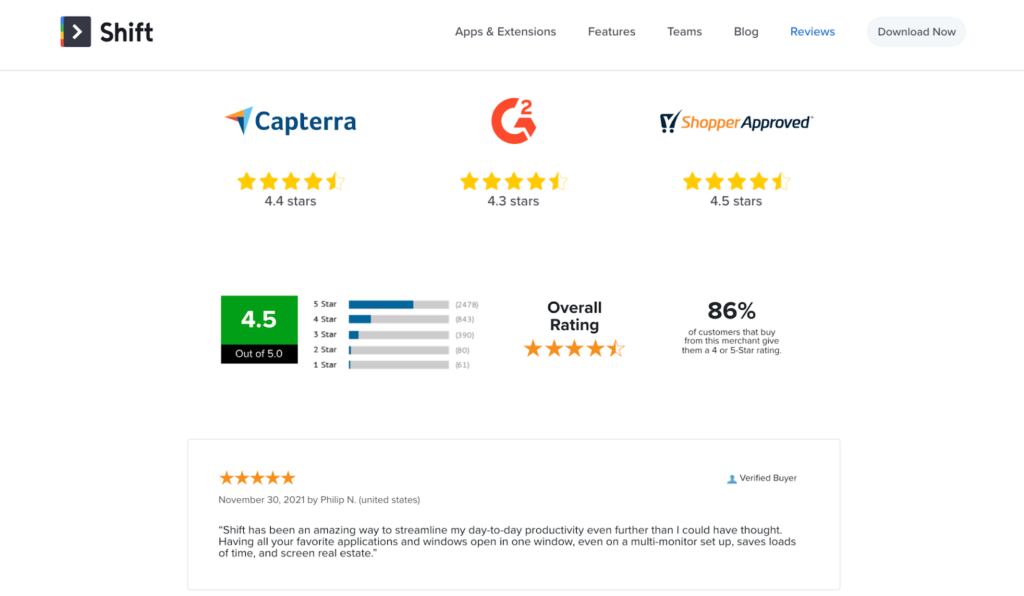
Shift (productivity app to manage multiple Gmail accounts and apps) has a reviews page that highlights reviews and scores across three review sites and pulls in reviews via the B2C-focused review site, Shopper Approved.
Keap (CRM, Sales & Marketing Automation) has a Reviews page that features reviews from four review sites: Capterra, G2, SoftwareAdvice, and Trustpilot. Keap highlights the reviews allow buyers to hear from “real customers”, which is supported in the page header and the image of real customers.
On a Conversion Page – Supporting the call-to-action to contact Sales, get started, etc.
Aircall (Cloud-Based Call Center Software) adds a trust section on their pricing page and has placed it between the pricing tiers section and the detailed pricing section, an excellent way to weave in reviews on a pricing page.
Thryv (CRM and Marketing Automation Software) uses review social proof on their free trial page to support the CTA on the page to get started.
On a Product page – Supporting specific product lines.
HubSpot has five product “hubs,” including HubSpot Marketing Hub. HubSpot displays the G2 badges that they’ve earned for that particular product to help support their product messaging on each product hub page.
On HubSpot’s Sales Hub page, they use the same header message – “Consistently praised by HubSpot users on review site g2.com” – but they use the badges earned for this product, Sales Hub.
Freshworks has five products: Freshmarketer, Freshsales, Freshdesk, Freshservice, and Freshteam. Freshworks uses its product-specific badges for each product page. For example, Freshmarketer (Marketing Automation Software) and Freshsales (CRM Software) use the G2 and GetApp leader badges alongside two Gartner Magic Quadrant accomplishments.
Freshworks adjusts the social proof section on the Freshdesk Freshdesk (Support and Customer Success software) product page to feature four badges that best support Freshdesk as a product.
In a news post or press release:
Intuit’s QuickBooks (Accounting & Finance Software) has built up one of the top profiles on G2. To share their accomplishments, they wrote a news article that they posted on their blog.
QuickBooks displays their top G2 badges in the post, including a Top 50 Products for Finance.
HubSpot (All-In-One CRM Software) wrote a news post on its award-winning accomplishments on multiple B2B software review sites.
Pipedrive (Sales-first CRM and intelligent revenue management platform for small and medium-sized businesses) wrote a press release on its Top Rated 2021 awards from TrustRadius.
Semrush (SEO software) wrote a new article on their impressive G2 accomplishments, which includes ranking #1 in eight categories, achieving Leader status in 19 categories on G2, and being named one of the Best Global Software sellers alongside the who’s who of enterprise software, such as Microsoft, Google, Zoom, Slack and others.
In a community post
Asana (Project Management Software) has shared its G2 successes with its community in a post on its community forum.
On your partner page(s)
Rewind (online backup service for SaaS applications, starting with e-commerce platforms Shopify and BigCommerce, and also supporting QuickBooks Online) leverages its high review scores from the three main platform ecosystems that it supports. Rewind highlights these review scores on their partner program page to demonstrate how satisfied their customers are on each platform to potential partners.
ActiveCampaign (Marketing Automation Software) makes extensive use of G2 badges on the Affiliate Partner page to support their partner pitch, “Refer your followers to a platform they will actually love…(ActiveCampaign is a) top-rated platform across multiple categories on review sites like G2.”
On your landing pages
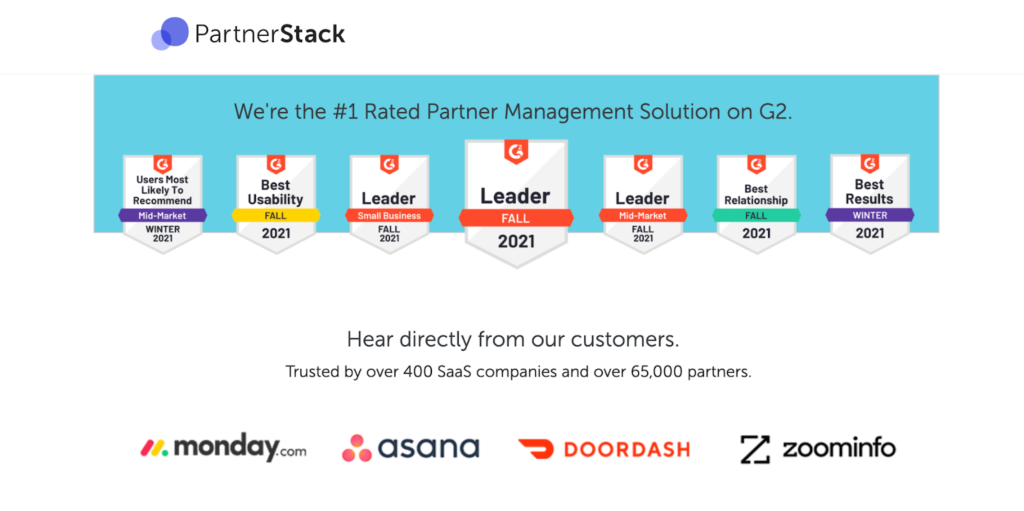
At PartnerStack (Partner Management and Affiliate Marketing Software), we leverage G2 badges on most of our landing pages. Here’s an example of how we use G2 badges to support our position as the #1 rated Partner Management Software on G2 and couple it with some customer and partner proof.
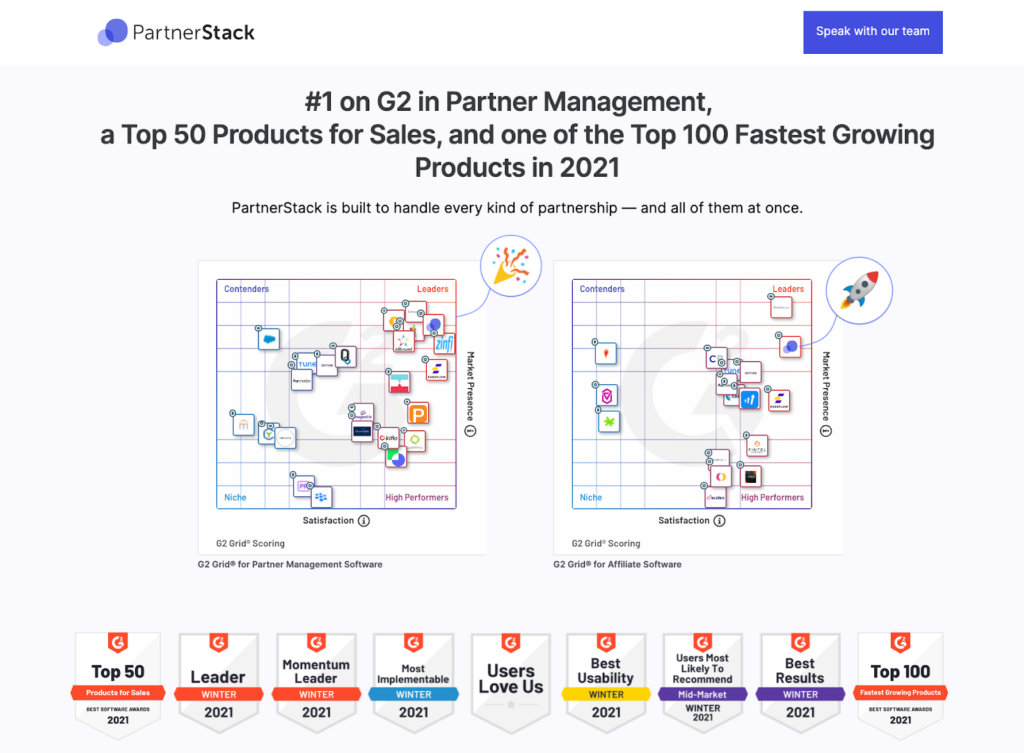
In another PartnerStack landing page, we advertised in SaaStr’s email newsletter for two months in the Spring of 2021. Our sponsored message led to a landing page with this section on how PartnerStack ranks on G2.
We leveraged the G2 Live Category Grid® Widgets for Partner Management and Affiliate. These widgets are “live, interactive, current, and customizable.” and you can “Adjust the segments you display, along with the size, look, and feel of your G2 Widget to fit your branding.” So while the badges are static (Winter 2021 badges are based on the review period of Sept – Nov 2020; see the G2’s Research Agenda for more dates), the grid widget adjusts in real-time, so the placement of vendors on these grids would have different back in Spring 2021. The way you see them here is where things stood as of Dec 4, 2021 (the image is a screenshot of the page with the widgets).
The two widgets shown in the screenshot are the “medium” sized version of the widget (400 x 400px), and the segments are “all,” which means how vendors rank for all segments overall. If you choose a particular segment, the auto-generated title beneath the widget will adjust. For example, if we chose the “enterprise” segment for Affiliate, the title would change from “G2 Grid® for Affiliate Marketing Software” to “Mid-Market G2 Grid® for Affiliate Marketing Software”.
One important note on these live grids: each vendor icon is interactive. When a visitor clicks on a vendor icon, a small pop-up appears with the vendor star rating and the number of reviews and a link to “see reviews” (on G2).
ActiveCampaign (Marketing Automation Software) features G2 badges as social proof to help encourage more free trial starts on their landing page for their Google Ad on “marketing automation software” searches.
Semrush (SEO Software) has a user review section on their landing page for their brand search ad (“semrush software”), and explicitly calls out reviews as social proof (“Your peers think Semrush rocks”).
On social media
Social media, particularly LinkedIn in B2B SaaS, is a popular place to share review site achievements and customer voice in the form of highlighted user review reviews in social posts.
Here are some examples from B2B SaaS companies.
On social media profiles
Apollo.io (Sales Intelligence Software) highlights their G2 Momentum Leader and Users Love Us badges in their LinkedIn profile. This LinkedIn banner supports their review site positioning as the vendor with the most momentum in a crowded category. It is an effective way to communicate that they’re headed in the right direction faster than their competition.
Hippo Video (Video software for Sales, Marketing, and CS teams) uses G2 badges in its LinkedIn banner to support its “Category-leading” headline.
Sanebox (Email Management Software) put their G2 Leader status front-and-centre in their LinkedIn profile banner. The use of their Easiest to Use badge is a nice touch for a productivity tool like SaneBox.
In social media posts
Zoominfo (Sales Intelligence Software) combines a G2 badge and a review snippet from a decision-maker to support their status as #1 on G2 in Sales Intelligence.
Freshworks (all-in-one CRM) earned three 2021 Top Rated badges for Freshdesk and Freshservice from TrustRadius and proudly tweeted about their accomplishment.
SurveySparrow (Omni-channel Experience Management Platform) shared their achievement of being named (#12) on G2’s list of the Top 100 Fastest Growing Products in the 2021 G2 Best Software Awards. Previously, they made a press release for being named #1 on the 2020 edition of G2’s Top 100 Fastest Growing Products.
In Ads
LinkedIn Ads
If you scroll through your LinkedIn feed, you’ll see sponsored posts with review content in it, such as these examples:
1Password (Identity Management Software) highlights a particular review snippet that supports their “schedule a demo today” call-to-action by using the user voice to express how essential the 1Password solution is to their business.
PandaDoc (Quote Management Software) uses a short video that loops to show that PandaDoc is #1 in Quote Management and eSignatures Software and Quote Management Software).
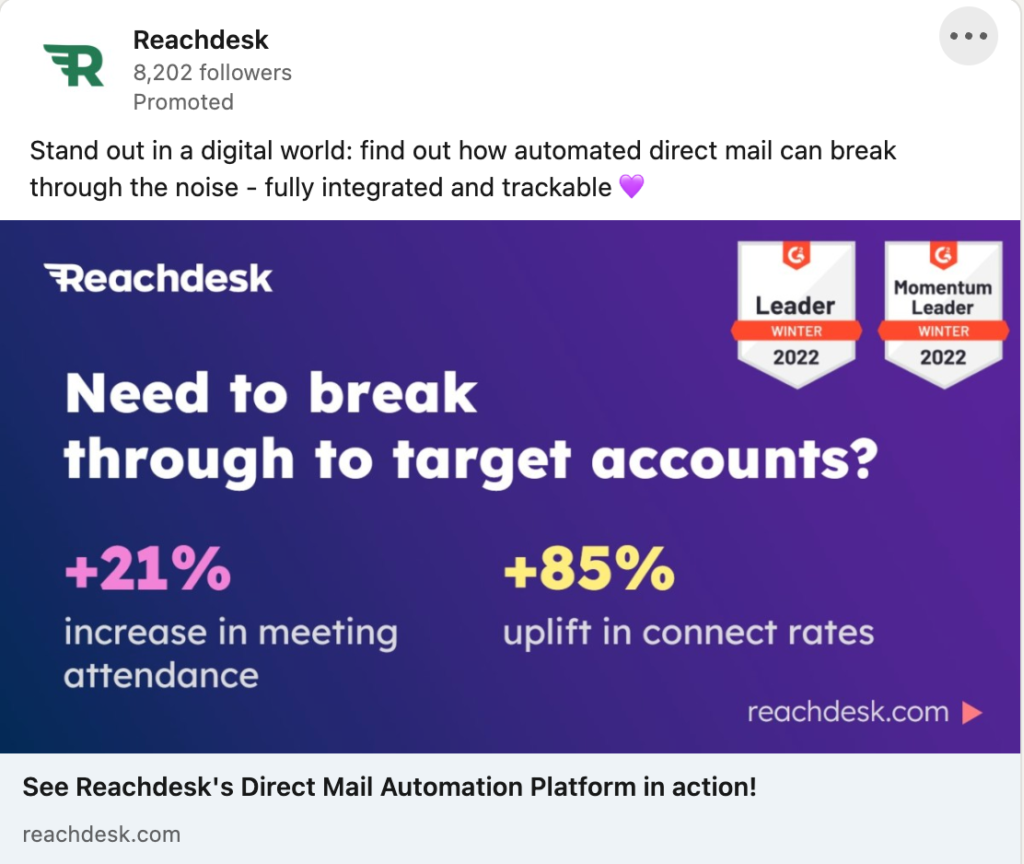
Reachdesk (Direct Mail Software) was the 5th fastest growing product on G2’s 2021 Best of Software lists and 18th fastest on the latest 2022 list. Reachdesk is leveraging its G2 momentum leader and category leader status as social proof in their LinkedIn ads to support their primary message (that Reachdesk will help you break into target accounts).
Remarketing ads
Remarketing ads are a popular and effective use case for highlighting review site ratings and accomplishments.
I often see B2B SaaS vendors retarget me with display ads featuring G2 social proof. Here are a few examples.

Drip (eCommerce email marketing) features their G2 star rating as a bullet point message in their retargeting ad.

Gong (Revenue Intelligence Software powered by call recording) uses a simple text retargeting ad that highlights their whopping 2,077 5-star reviews to support their call-to-action to learn more (about how Gong can help drive more revenue for you).
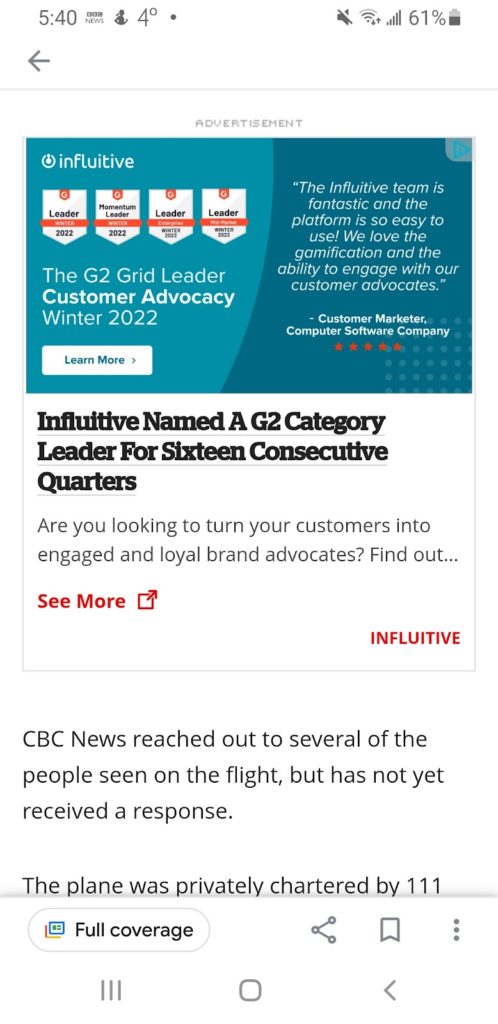
Influitive (Customer advocacy software) continues to be a leader in the category that it defined – customer advocacy – and is retargeting its site visitors with an ad that reinforces that leader status. Influitive makes use of four G2 badges not only to strengthen its leadership position but also to highlight that its a leader in the Mid-Market and Enterprise segments to appeal to its typical buyers (i.e. larger companies).
In email

ActiveCampaign (Marketing Automation Software) sends this email with G2 reviews and badges to communicate what users love about ActiveCampaign.
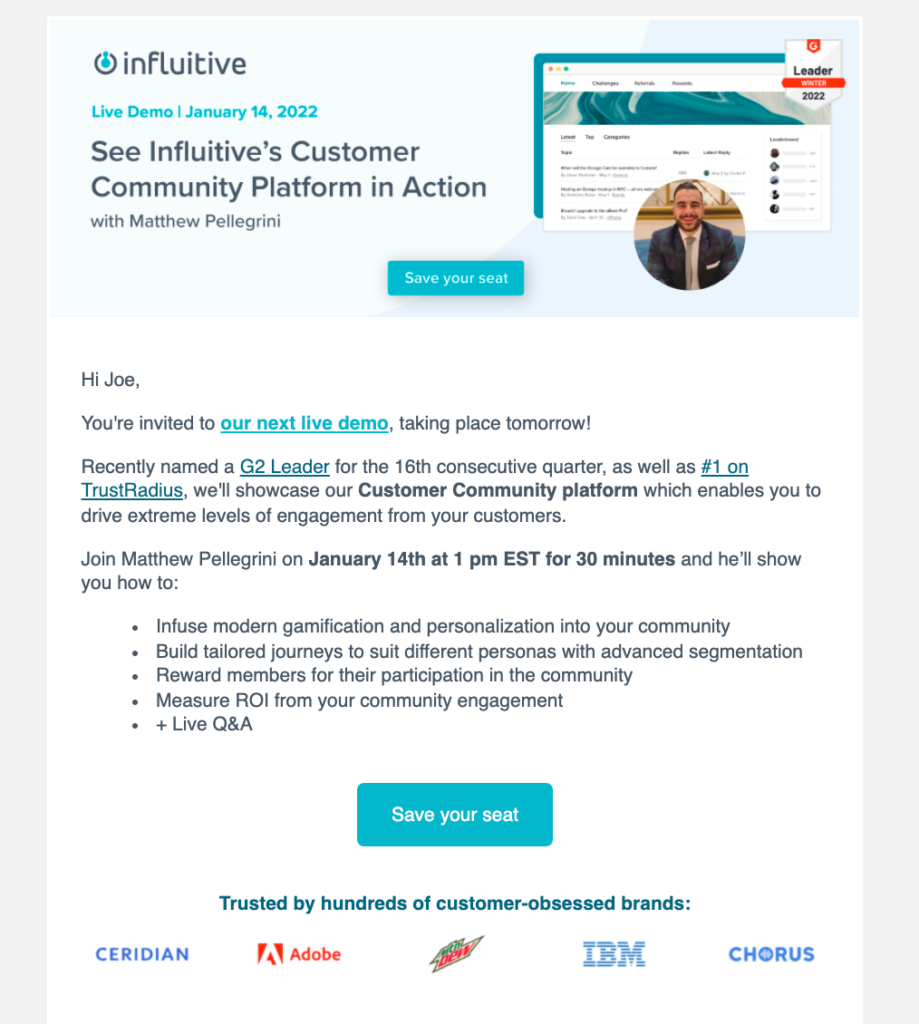
Influitive (Customer advocacy software) sent an email invite to prospects for a live demo. To attract prospects to attend, Influitive used review social proof in the email subject (“See G2 and TrustRadius’s top custom community platform in action tomorrow”), as well as in the email copy (“Recently named a G2 Leader for the 16th consecutive quarter, as well as #1 on TrustRadius, we’ll showcase…”), topped off with a G2 Leader badge in the email banner.

Reachdesk (Direct Mail Software) signs off their emails with a row of G2 badges and uses the G2 icon to refer recipients to Reachdesk reviews on G2.
Email signatures

1Password (Identity Management Software) combines the social proofing of 80,000 businesses using their software with three leading sites naming 1password the best password manager (as rated by users on G2 and Trustpilot) and technology experts at Wired).
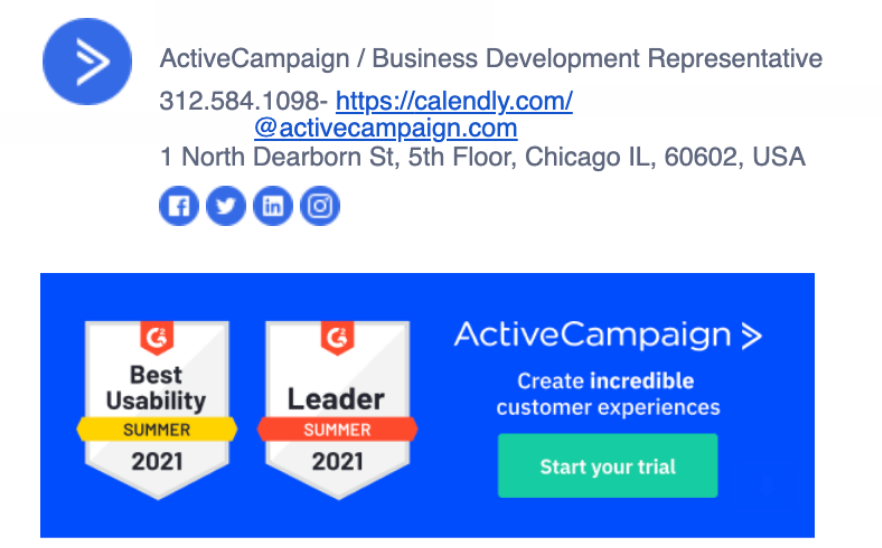
ActiveCampaign (Customer Experience Automation Platform) BDRs use G2 badges in their email signature to support the call-to-action to start a free trial.
At Conferences and Tradeshow On Your Booth
Brex (all-in-one finance for growing businesses) used both G2 and Trustpilot elements on their booth at SaaStr Annual 2021

Aircall (Cloud-Based Call Center Software) booth mockup uses Aircall’s G2 rating, G2 Leader badge, and a review snippet as a testimonial on their trade show booth.
9 ways to leverage B2B software user reviews
Review sites are a lead channel in the form of referral-based distribution.
In other words, the places like G2 and app marketplaces where software users rate and review the software and also sources of leads for vendors, as PartnerHacker has highlighted in The Partner Hacker Handbook.
Beyond generating leads, using reviews as social proof in external communications, and celebrating review site achievements in internal communications, there are other use cases for software reviews.
TrustRadius highlighted these four additional use cases:
Access to customer references
Competitive intelligence
Reputation management
Sales enablement
In addition to these five use cases highlight by TrustRadius, there are four more use cases:
Create advocate content based on reviews
Write better product copy
Engage social media users
Improve SEO
Support social selling with social proof
Let’s have a quick look at each.
1. Customer References
For many B2B SaaS buyers, due diligence includes speaking with a customer reference or two. The bigger the purchase decision, the more likely the buyer will request a customer reference.
References can be a challenge for B2B SaaS vendors because usually, there’s more demand for customer reference calls than there is supply to provide them. Many vendors tend to turn to a relatively small percentage of their customer base that they know are advocates for them (the vendor).
But turning to the same references too often can lead to burnout, which could jeopardize the customer’s willingness to be a reference. The result is that vendors have many strategies for how to respond when prospects ask for customer references, several of which attempt to avoid providing a customer reference. If a buyer asks for a reference and doesn’t get one, then the likelihood of purchase goes down—a poor result for buyer and vendor.
Reviews and review sites can lessen the divide. Reviews can provide the customer voice that buyers seek and minimize the need for the buyer to speak directly. Review sites can help build a larger pool of customer references. For example, G2 asks a question in the review process if the reviewer would be willing to be a reference for the vendor. For PartnerStack, more than half of its reviewers opted to be reference clients.
Not only does this expand the pool of references for Sales to call upon when needed, but it also enables the vendor to make G2 reference pages of customer quotes easily (video and written), reviews and other resources that help.
Here is an example of a G2 Reference Page for PartnerStack that features customer quotes and reviews from Maropost (Ecommerce + Multi-Channel Marketing platform), Typeform (Survey Software), and Unbounce (Landing Page software), among others.

2. Competitive intelligence
To help buyers find and evaluate their options, review sites do a great job of organizing solutions into categories and comparing vendors against one another. Consequently, review sites are also a great source of competitive intelligence.
Kyle Coleman, SVP Marketing at Clari, recommends job seekers, especially in Sales, learn about their potential employer’s competition by reading online reviews on sites like G2, TrustRadius, and Capterra.
Powered By Search, a B2B SaaS-focused marketing agency, shared how one of their customers, Loopio, gathered valuable information on what their competitors’ customers said in their reviews, and used that information in their positioning and messaging.
3. Reputation management
Gartner defines reputation management as:
“The practice of influencing stakeholder perceptions and public conversations about an organization and its brands. It includes monitoring perceptions and conversations, responding to reputation threats and proactively seizing opportunities to boost reputation.”
Reviews and review sites can and do play a role in each of these elements of reputation management. In Fact, in LinkedIn’s research on tech buyers, they consider brand reputation, reviews and recognition as one (what are others saying about the software?).
A B2B software vendor can also boost its reputation simply by generating reviews online to let its customers share their thoughts on the software. Happy reviews boost the solution’s reputation, and vendors can respond to unhappy reviews.
At PartnerStack, before we had a person dedicated to brand/reputation management, we saw building up our reviews as an important part of branding.
In addition, reviews on reviews sites start more public conversations, which is a great way to proactively seize opportunities to boost reputation.
For guidance on responding to negative reviews, see this G2 post: Got Negative Customer Reviews? 10 Experts Share Tips on How to Respond.
4. Sales enablement
Gartner defines Sales Enablement as “the process of providing the sales organization with the information, content and tools that help salespeople sell more effectively.”
One thing that salespeople often ask Marketing for is more customer success stories. By generating reviews, Marketing creates user-generated content that lets the customer tell the story.
Reviews are a great compliment to case studies. Vendors typically have more reviews than case studies, but case studies tend to be more in-depth than reviews. Sales can leverage both the breadth of customer stories pulled from user reviews and the depth of case studies.
You can also make a slide (or slides) that leverages your reviews. For example, here’s a slide that PartnerStack has had in its master sales deck.
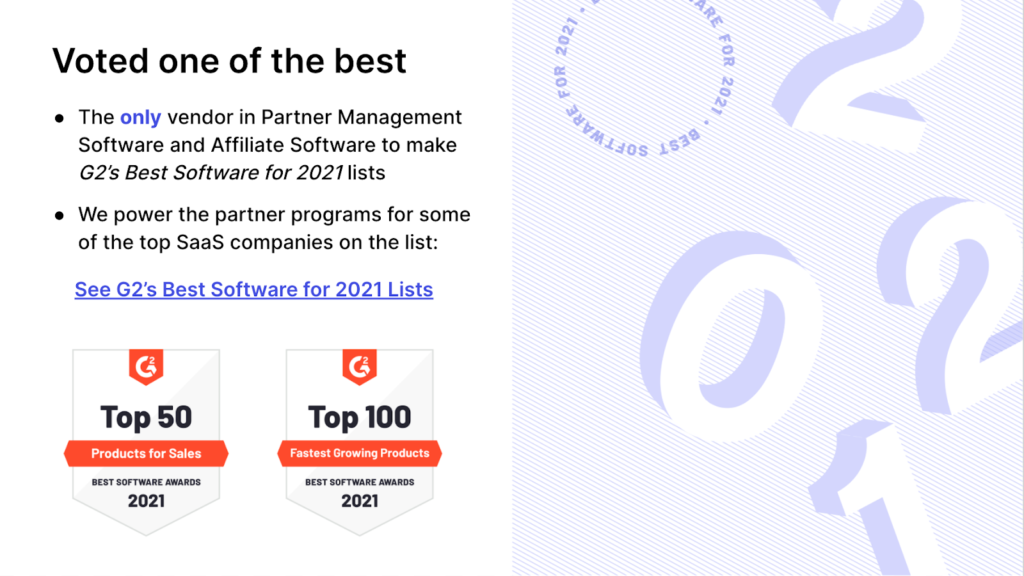
5. Create advocate content based on reviews
Reviews are just one form of user-generated content. You can turn a review into a testimonial, a tweet, or a case study.
When it comes to reviews, buyers tend to be willing to read more than what’s there in a typical review, which makes turning reviews into case studies a natural extension.
One current trend for B2C reviews is that they’re getting shorter. “The average (B2C) review has gotten 65 percent shorter since 2010 and is now roughly the size of a tweet (from an average of 600 characters (120 words)per review to just over 200 characters (40 words)).
While reviews on B2B review sites tend to be longer than B2C reviews, they only average a few hundred words per review.
For context, the average blog post has 1,151 words (as of 2018, and the number is increasing).
For case studies, DocSend analyzed 34 million Sales content interactions and found that the sweet spot for a case study length was 2-5 pages in length based on completion rates (meaning buyers would read more than 1 page but start to drop off after five pages).
Assuming a double spaced format and each page as roughly 250 words, buyers will complete a case study ranging from 500 to 2,500 words.
In short, buyers would read more than is in the typical business software review. As a vendor, you can expand on the story of your best reviews in various ways. HubSpot outlines four forms of case studies: written, video, infographic, and podcast.
If you’re looking to make testimonial videos based on great reviews, I’d recommend searching online for “remote video testimonials.” You’ll find vendors that can help you highlight your best customer stories and tell them in an engaging format that can help bring the story to life.
6. Write better product copy
What’s better than you trying to describe your software in a way that will resonate with your users? Read what your users say about your software and use what they say.
One of the most popular SaaS marketers, Dave Gerhardt, recommends coupling reviews with custom surveys and Gong customer call recordings to write better product copy. Rather than imagine what users want to hear, listen to what they’ve already said.
Content Beta Founder, Rish Bhandari, is also a proponent of review sites as inspiration for copywriting (see his comment on this post):
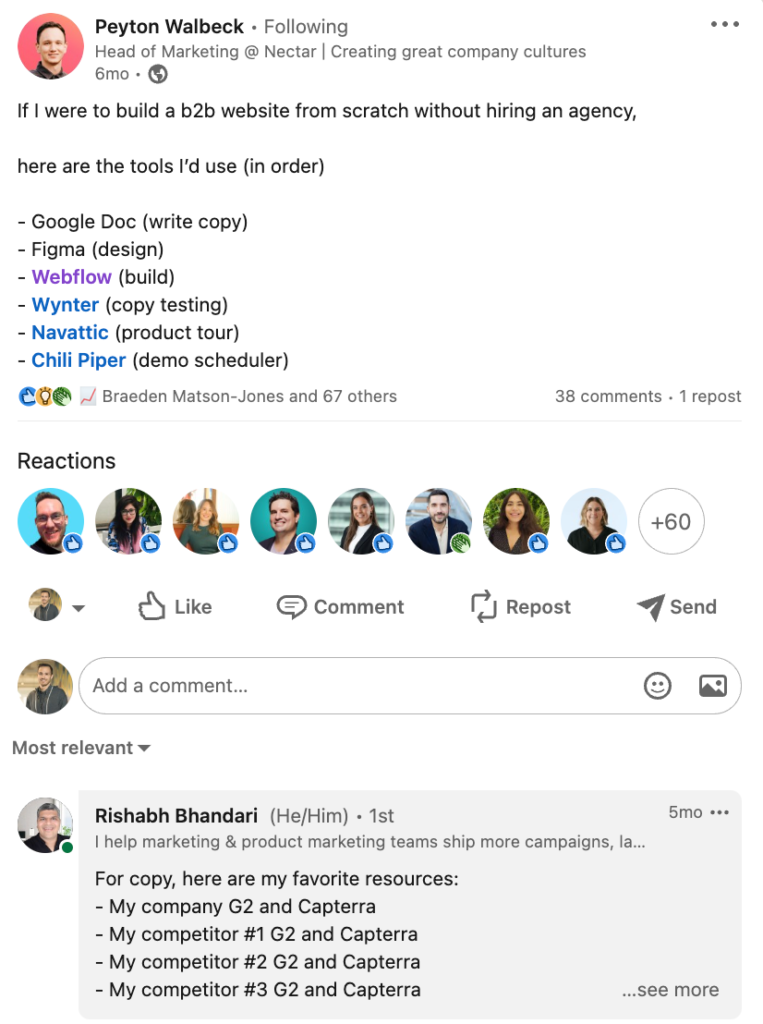
7. Engage social media users
When software buyers turn to social media or peer communities to ask others for input on a purchase decision, it can be challenging for the software vendor(s) in question to respond in a way that doesn’t come off too strong. After all, when these buyers are turning to social media for information, they’re often seeking input from other users.
Software vendors can leverage reviews to engage in these conversations. A software vendor can simply respond with a link to their reviews and let their users do the talking.
Sprout Social (Social Media Management Software) did this perfectly when a Marketer asked on Twitter for fellow marketers to help provide pros and cons on Sprout Social vs. HubSpot vs. Hootsuite.
Torn between @hootsuite @HubSpot and @SproutSocial. Help me out #marketers. Pros/Cons? Any testimonials? #digitalmarketer pic.twitter.com/RDCeNGEObH
— Van Shumake (@pixelsandpics) August 31, 2021
Sprout Social simply replied, “Hey 👋 if you have a few minutes to spare, check out what people have to say about Sprout Social on G2,” and linked to Sprout Social’s G2 reviews. The Marketer who tweeted for help replied, “Most definitely! Thanks.”
Most definitely! Thanks. pic.twitter.com/cvBSYNKGun
— Van Shumake (@pixelsandpics) August 31, 2021
8. Improve SEO
While review counts and review scores may not factor into Google search results (aside from Google reviews for local search rankings), “star ratings can serve as an important conversion element, helping you display social proof and build credibility” according to Search Engine Journal.


As shown above, when you add a software review site as a modifier to a brand name search, you may see their star rating and the number of reviews listed on the search engine result. In the examples above, a search for “partnerstack g2” yields a G2 result with the number of Partnerstack reviews on G2 (282), the average rating (4.8/5.0), and one of its top badges (Top 50 Products for Sales). A search for “partnerstack capterra” yielded similar results.
As B2B review sites and Google each experiment with adding review site information to search engine results pages, reviews will play an important role in whether a web visitor clicks on your search engine result.
Now that you know how to leverage your B2B software reviews, it’s time to learn how to measure their impact.
9. Support social selling with social proof
For those using LinkedIn for social selling, sometimes a message can benefit from social proof.
For example, the VP of Community for Apollo.io, Daniel Cmejla, made a simple post to get more buyers to make the switch to their platform.
While the offer – 30% off – is the crux of the message, there’s still the question of whether the solution is the same or better.
Daniel leveraged G2 user reviews to answer why users should consider switching, beyond the price difference. As an employee, of course, you’re going to say that your solution is the best, so leveraging reviews as a trusted third party is a credible way to answer why buyers should go with you.

Recapping how to leverage online reviews in B2B marketing and sales
After generating reviews, it’s time to leverage them. Look into review site buyer intent solutions to see if you can access the data on which accounts are looking at reviews relevant to you. Also, plan to incorporate review site information such as ratings, rankings, and review site badges into your website, social media posts, ads, and beyond. Don’t forget some of the less common uses of reviews, such as customer references, competitive intelligence, reputation management, sales enablement, and as a basis for case studies.
The better software vendors become at leveraging online reviews in their marketing and sales, the more they will keep pace with the way today’s software buyers want to make purchase decisions.
Author
-

I'm the Founder and Editor-In-Chief of B2B SaaS Reviews and the Director of Demand Generation at PartnerStack, the leading platform for partner management and affiliate marketing in B2B SaaS. My experience spans several notable B2B SaaS companies, including Influitive (Advocate Marketing), LevelJump (Sales Enablement, acquired by Salesforce), and Eloqua (Marketing Automation, acquired by Oracle). I hold a Bachelor of Commerce in Marketing Management from Toronto Metropolitan University and a Master of International Business from Queen's University, with academic exchanges at Copenhagen Business School and Bocconi University.

